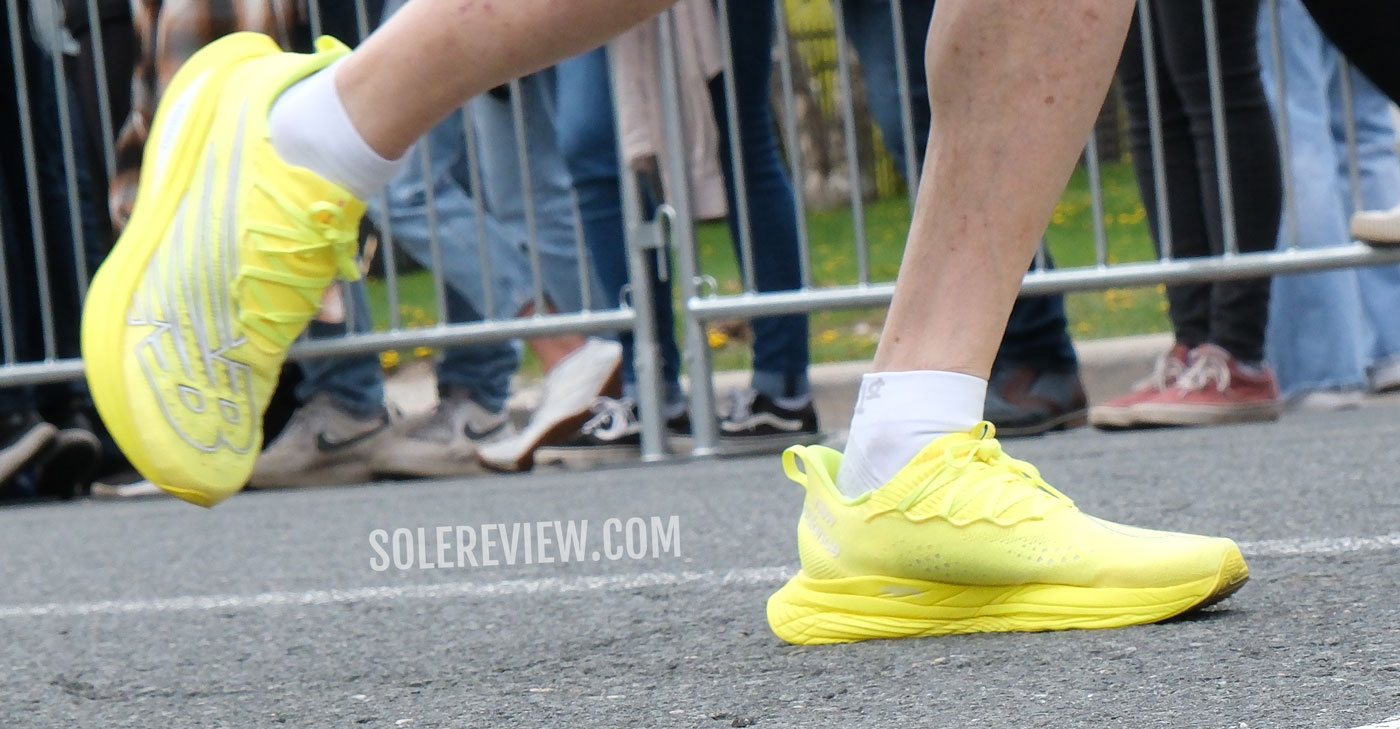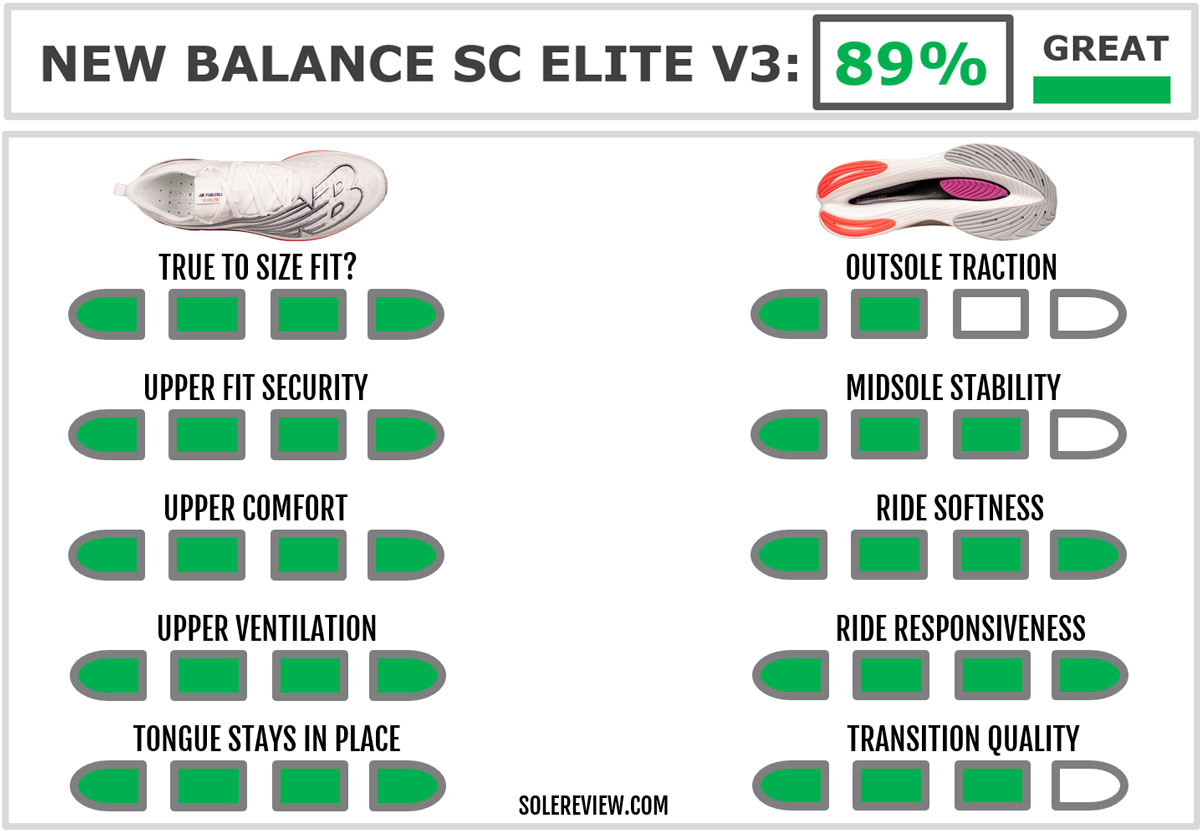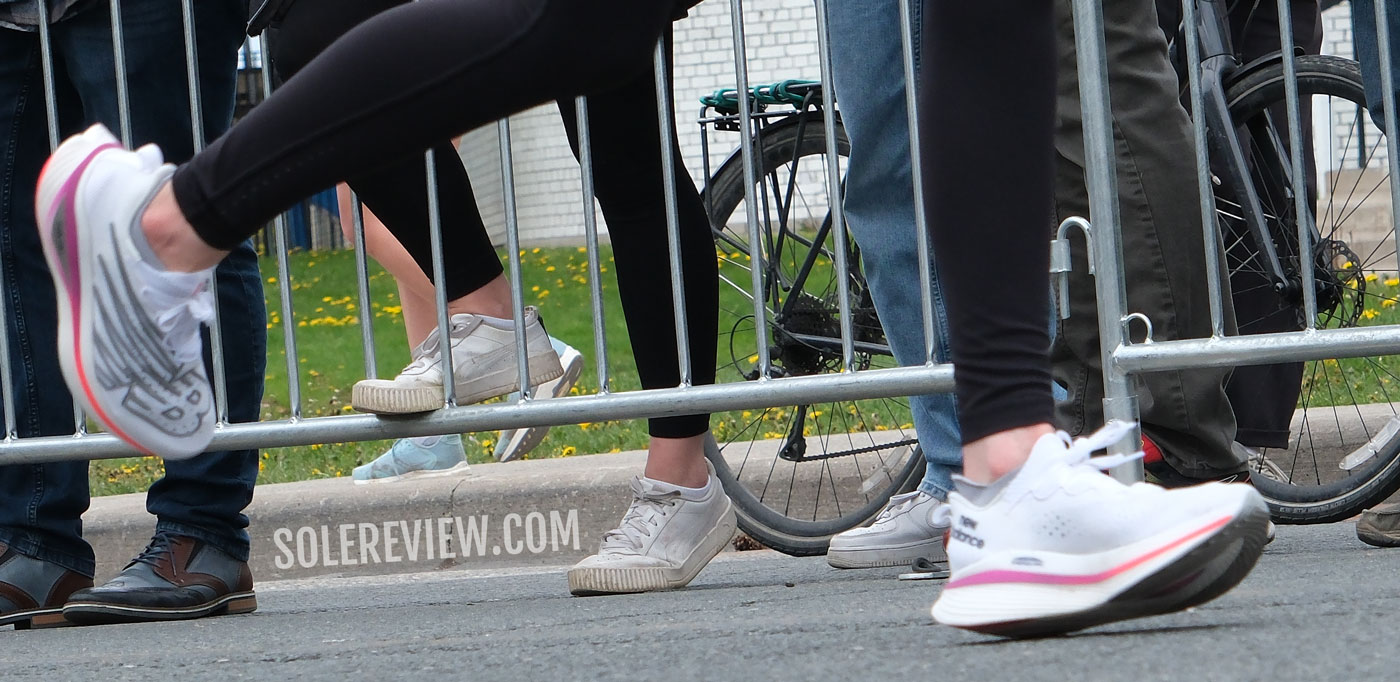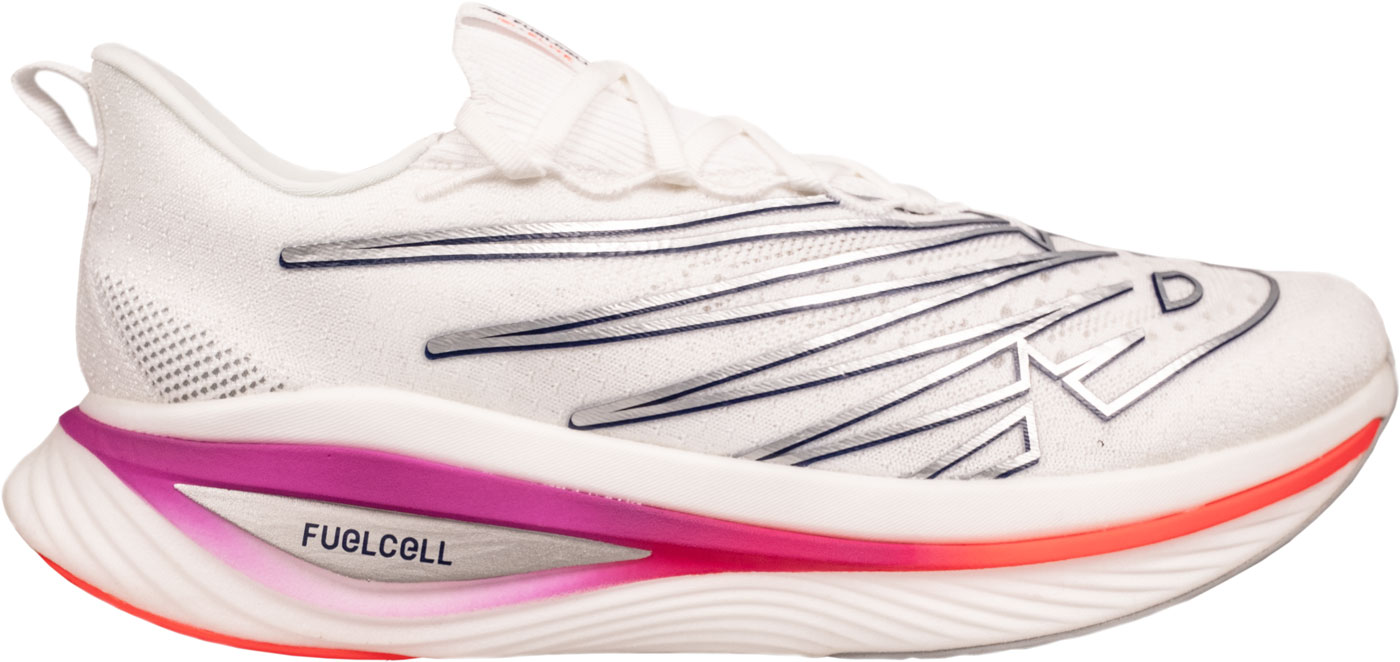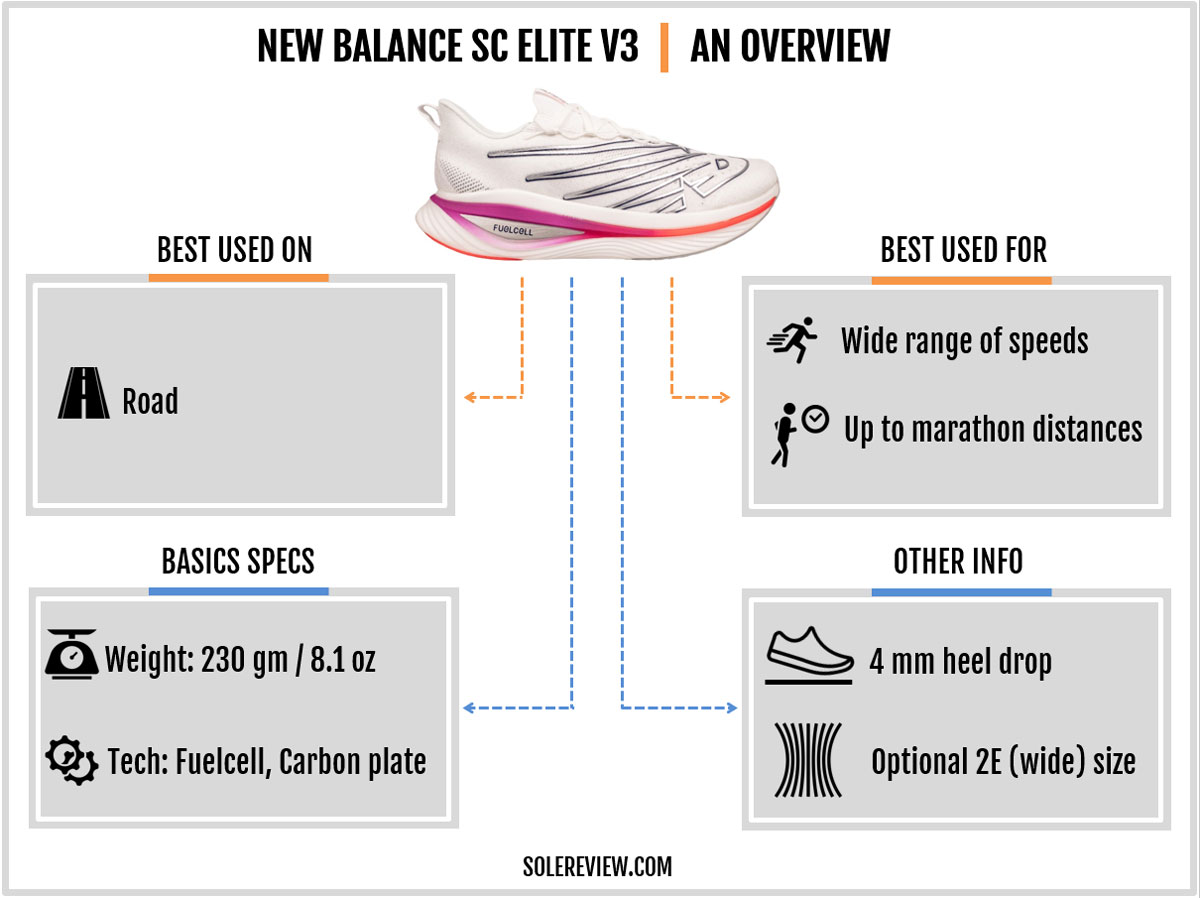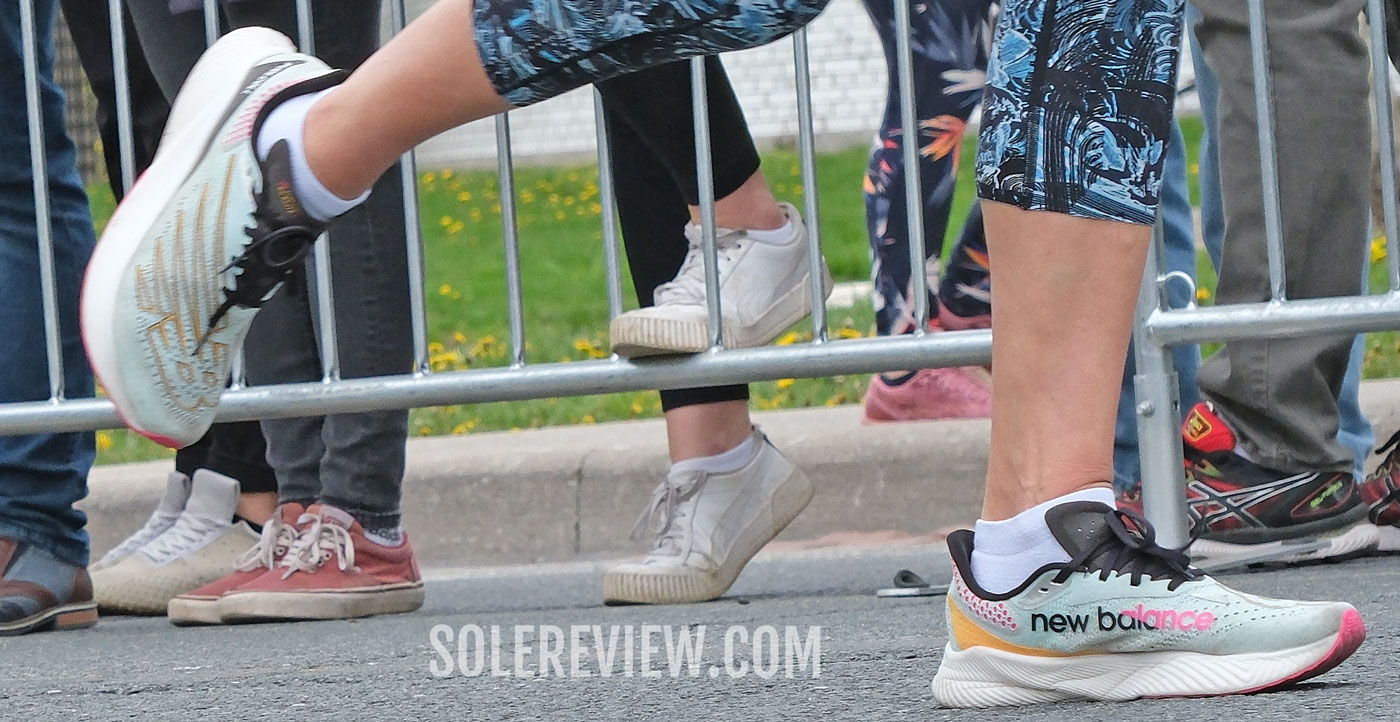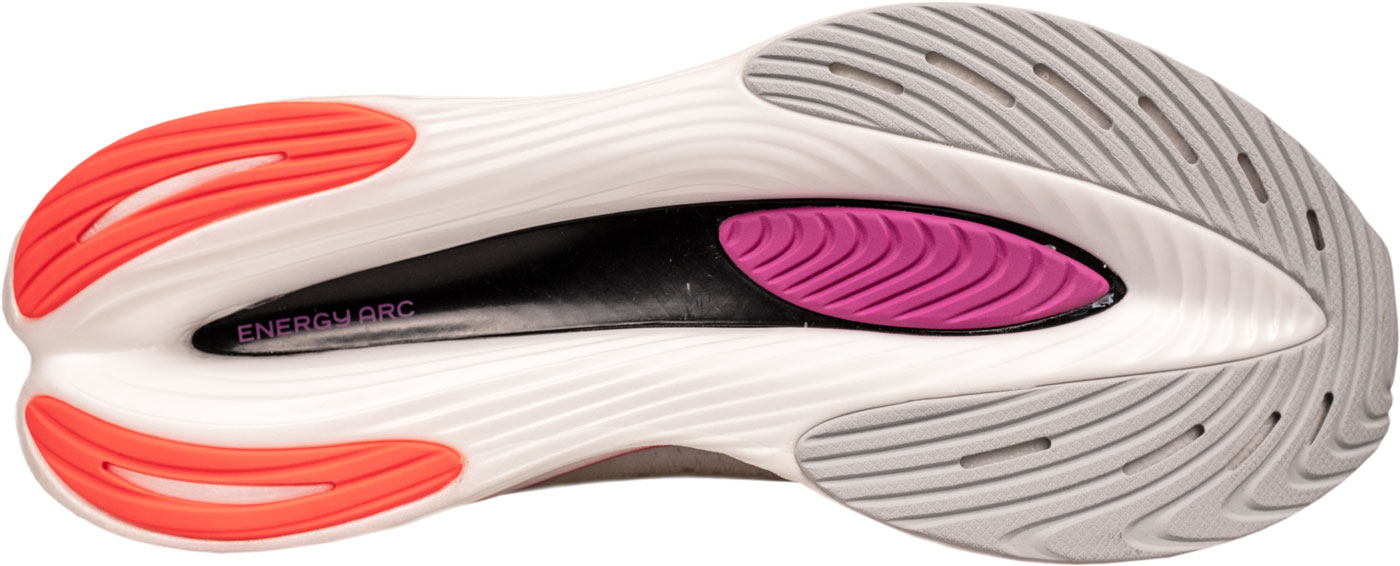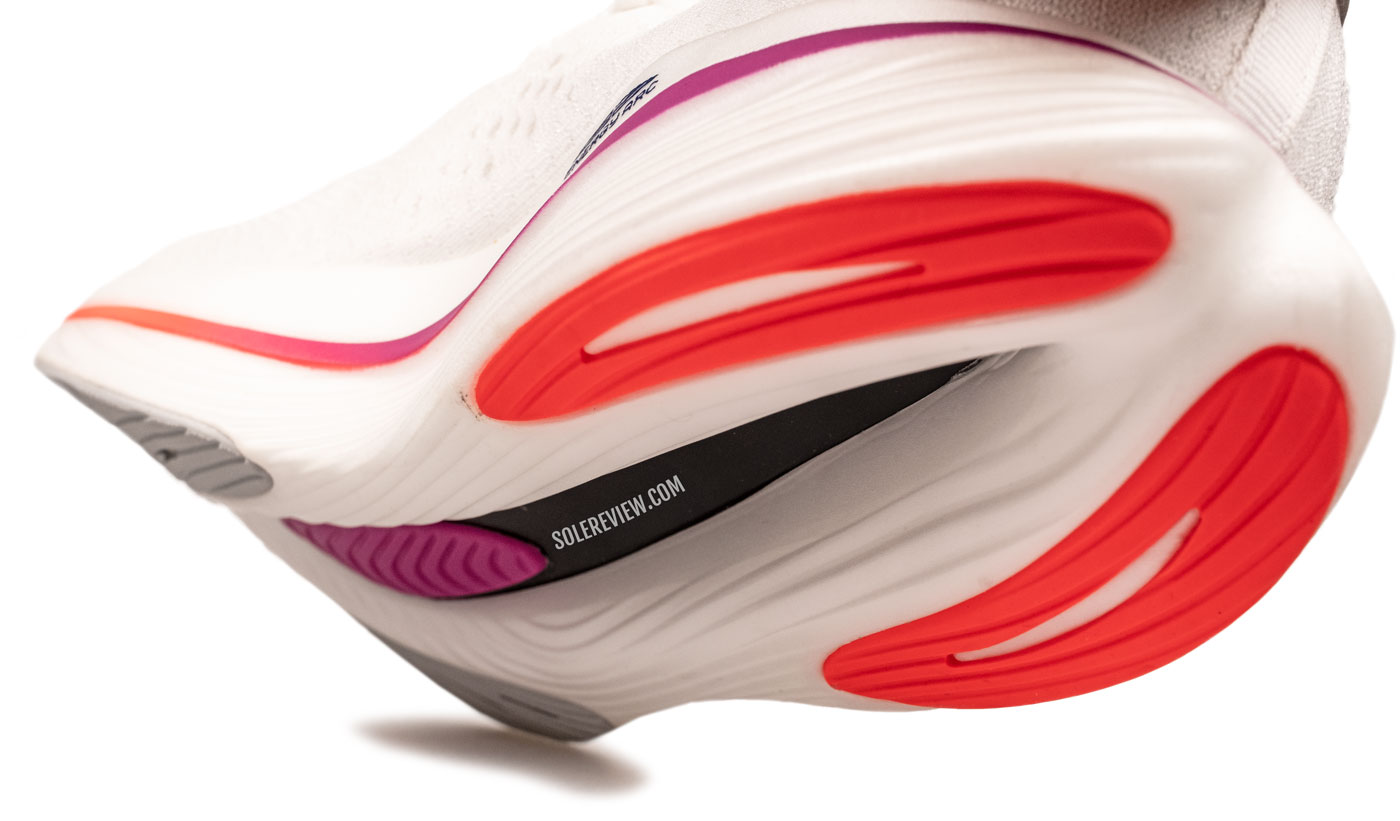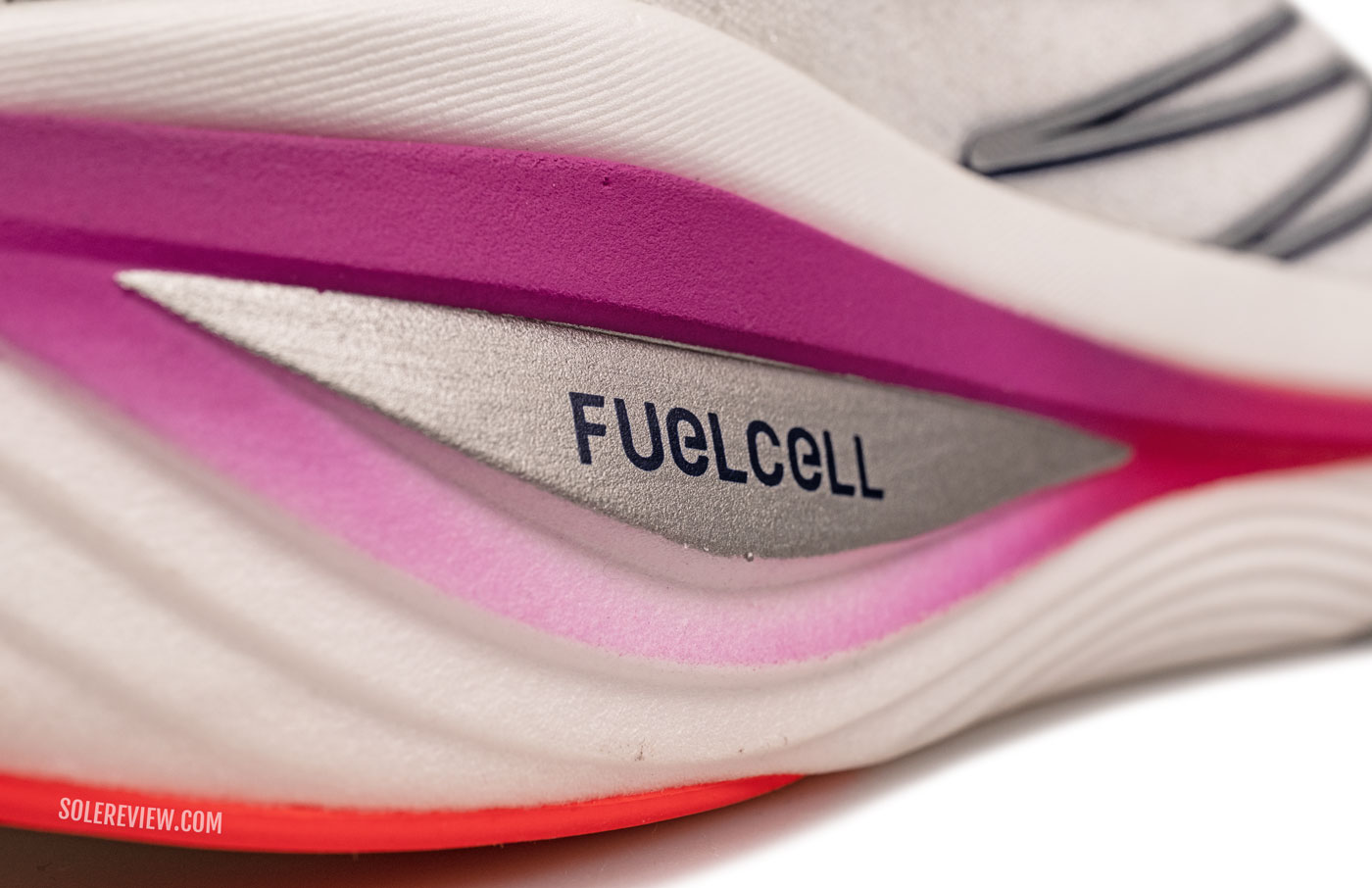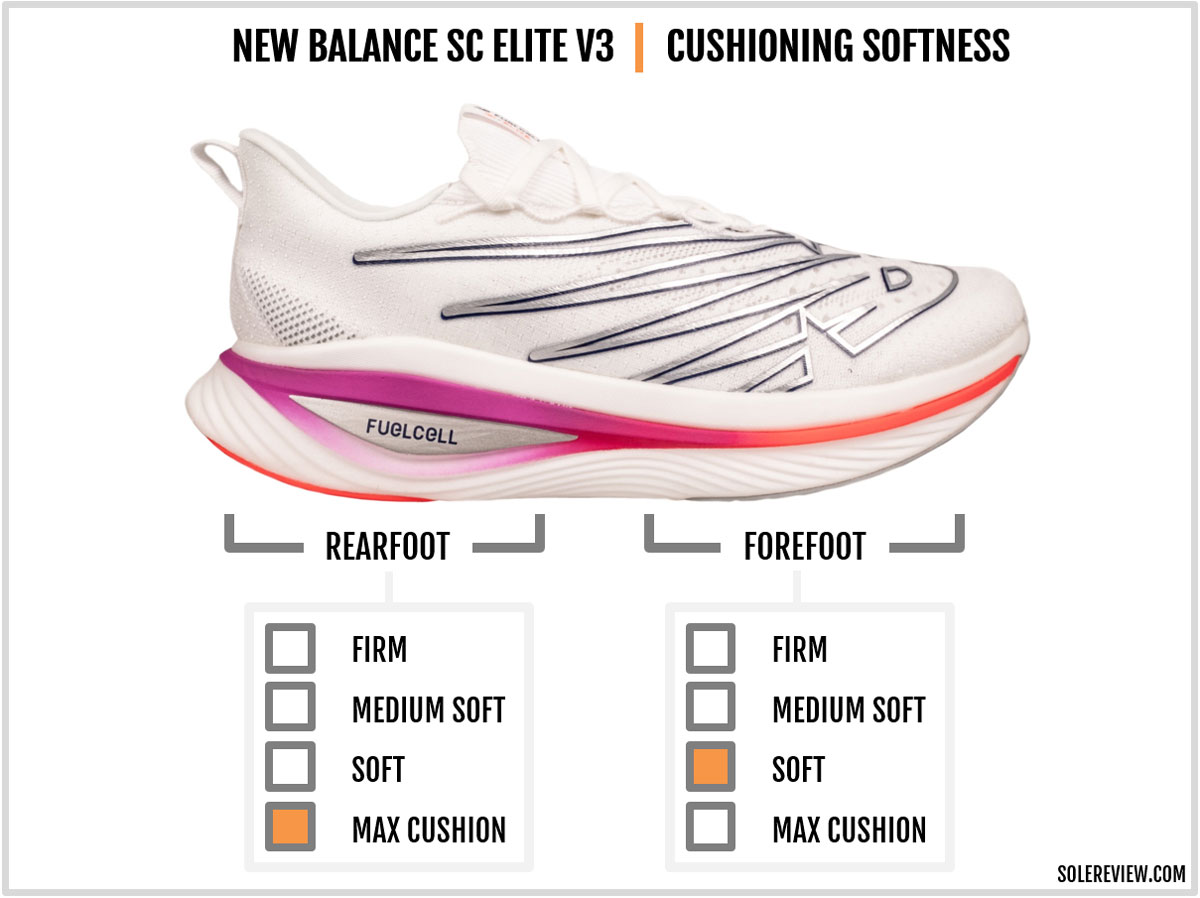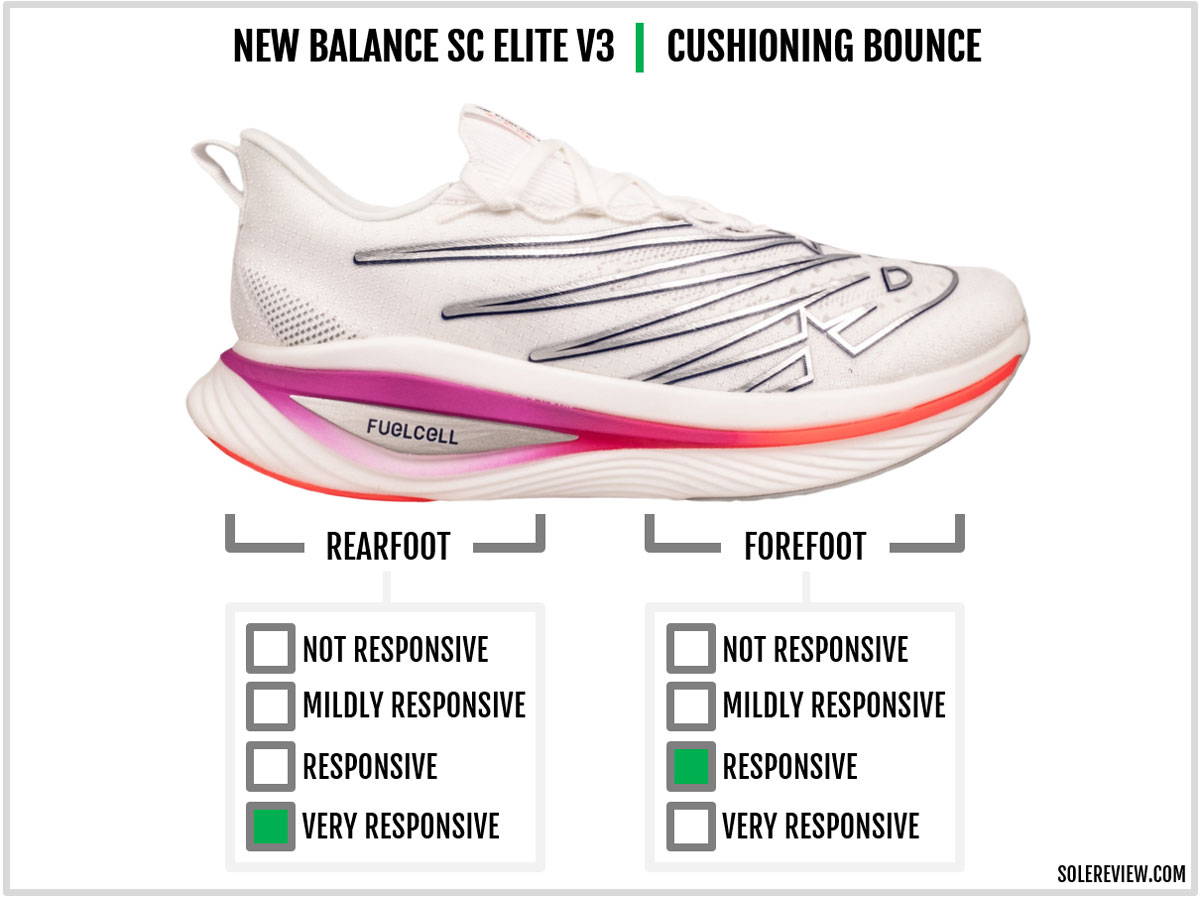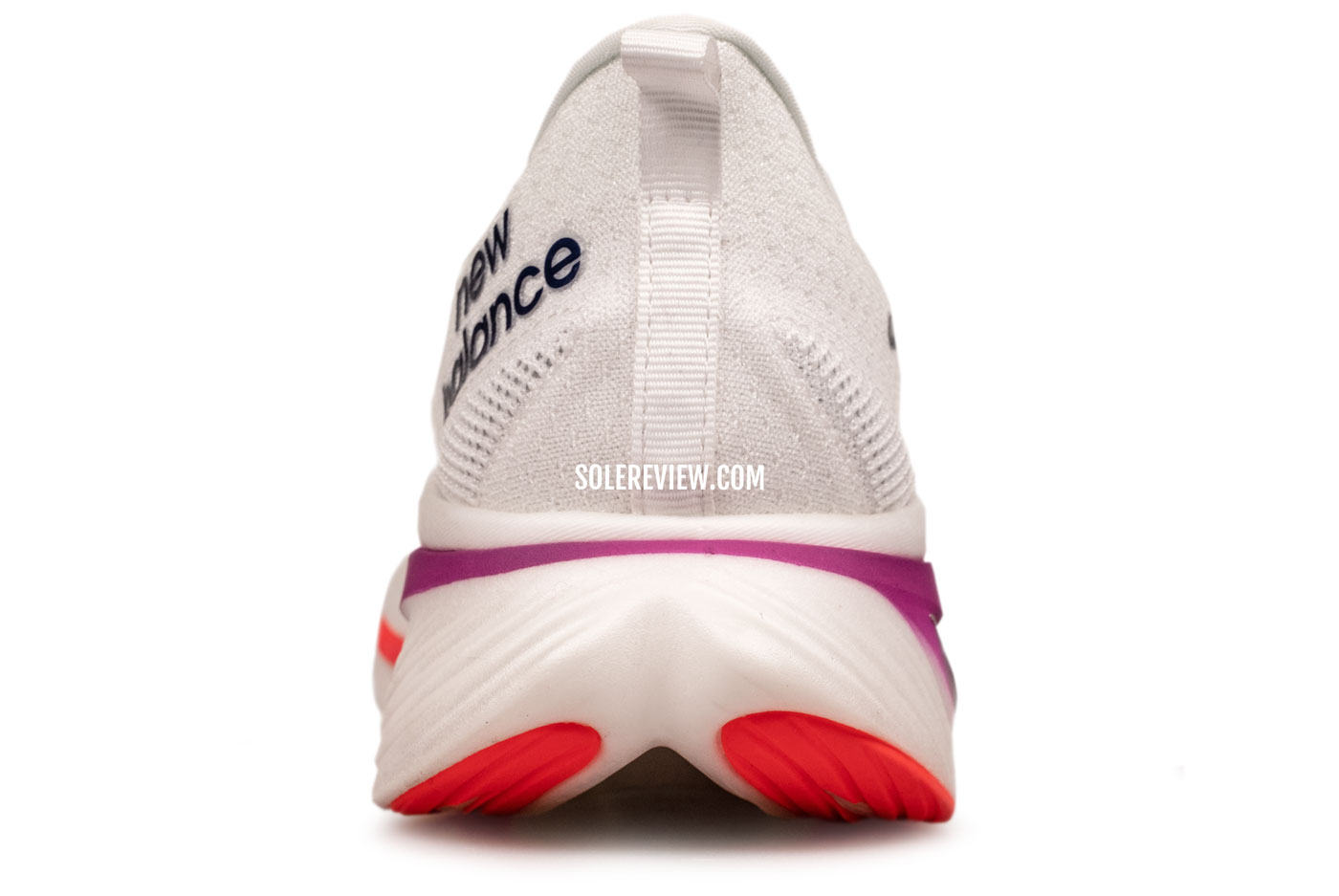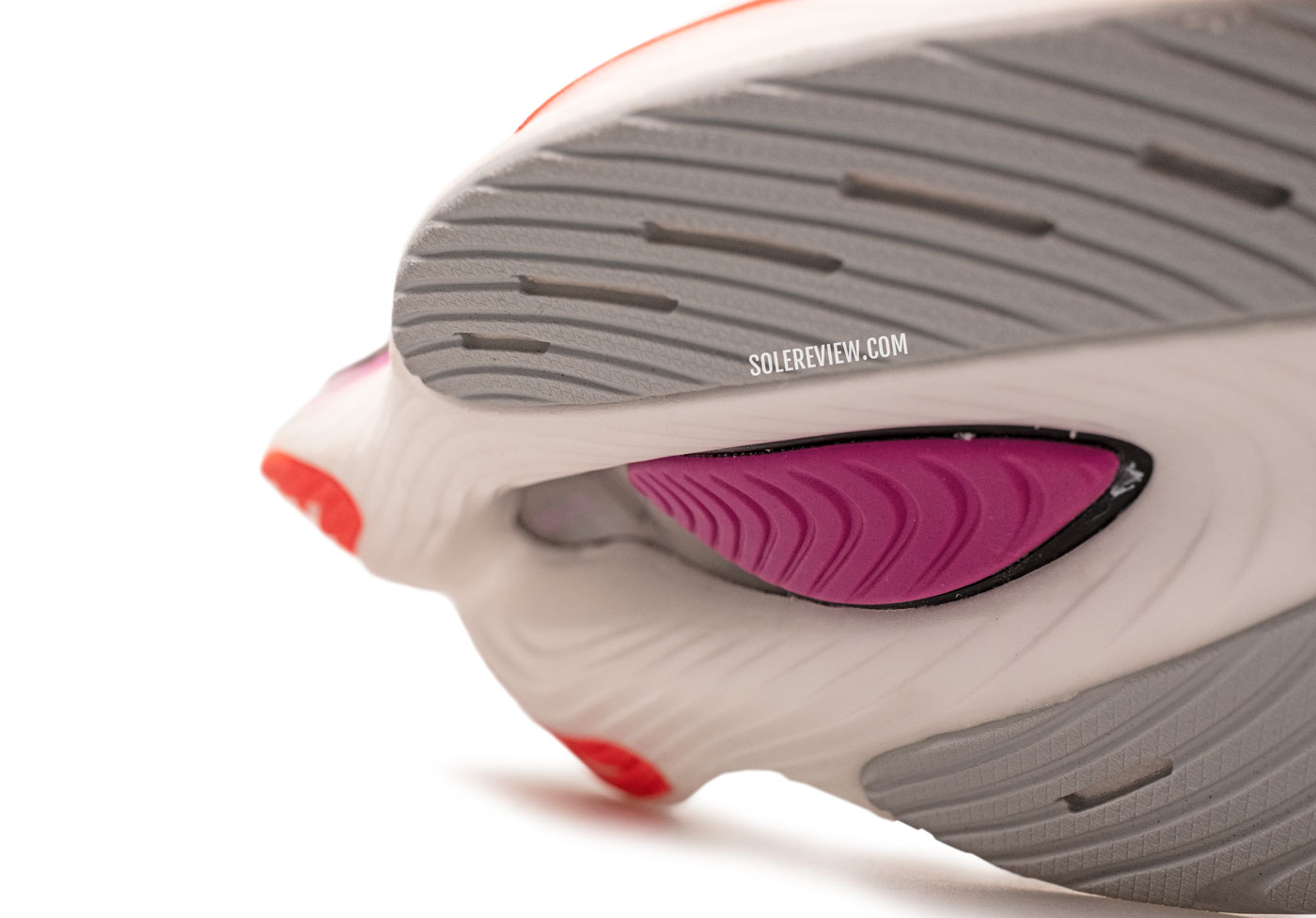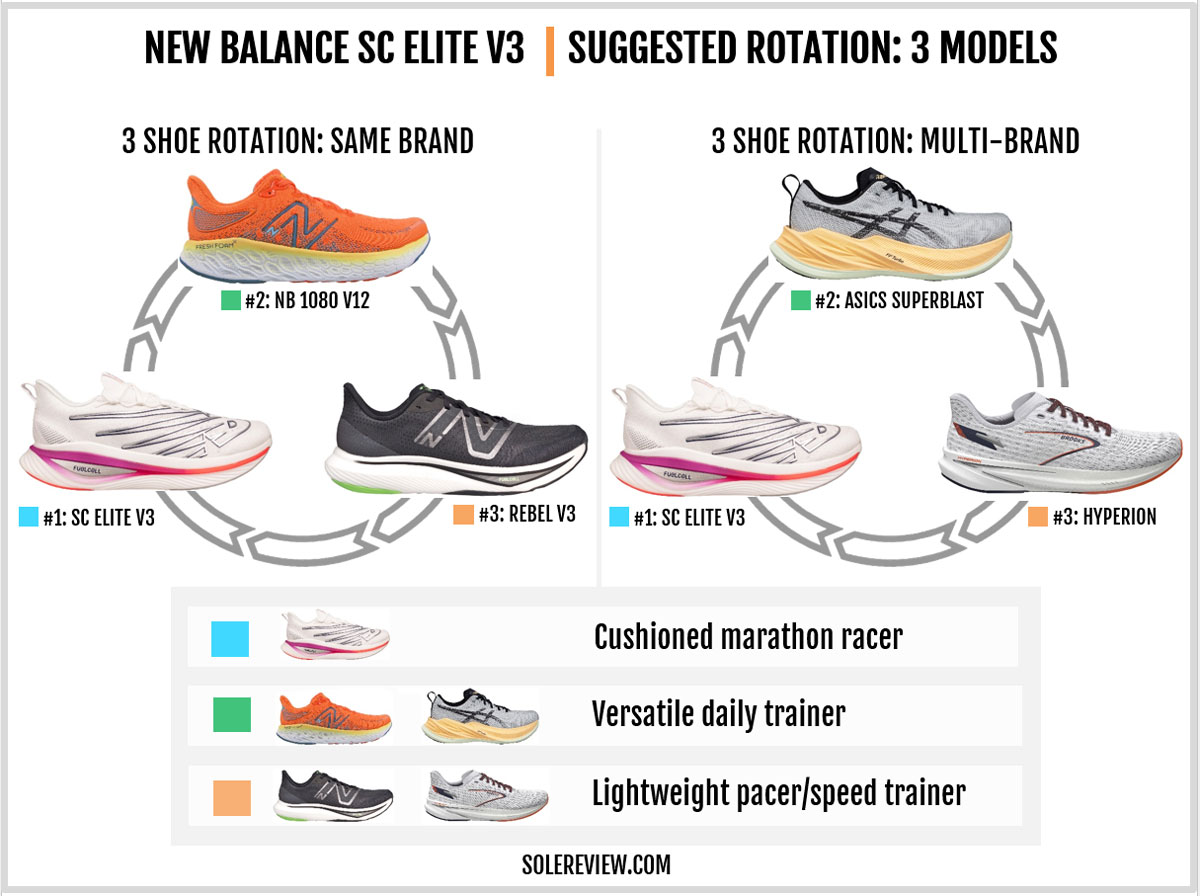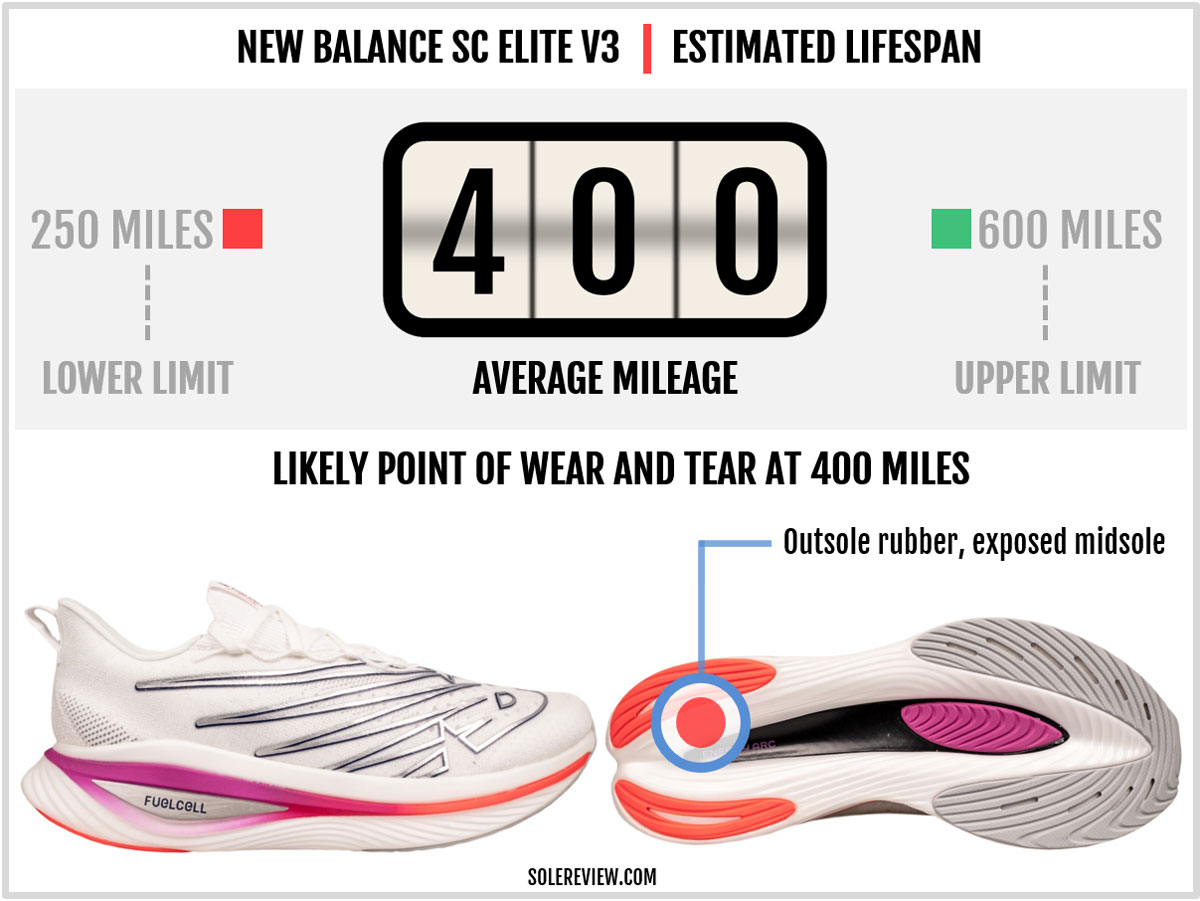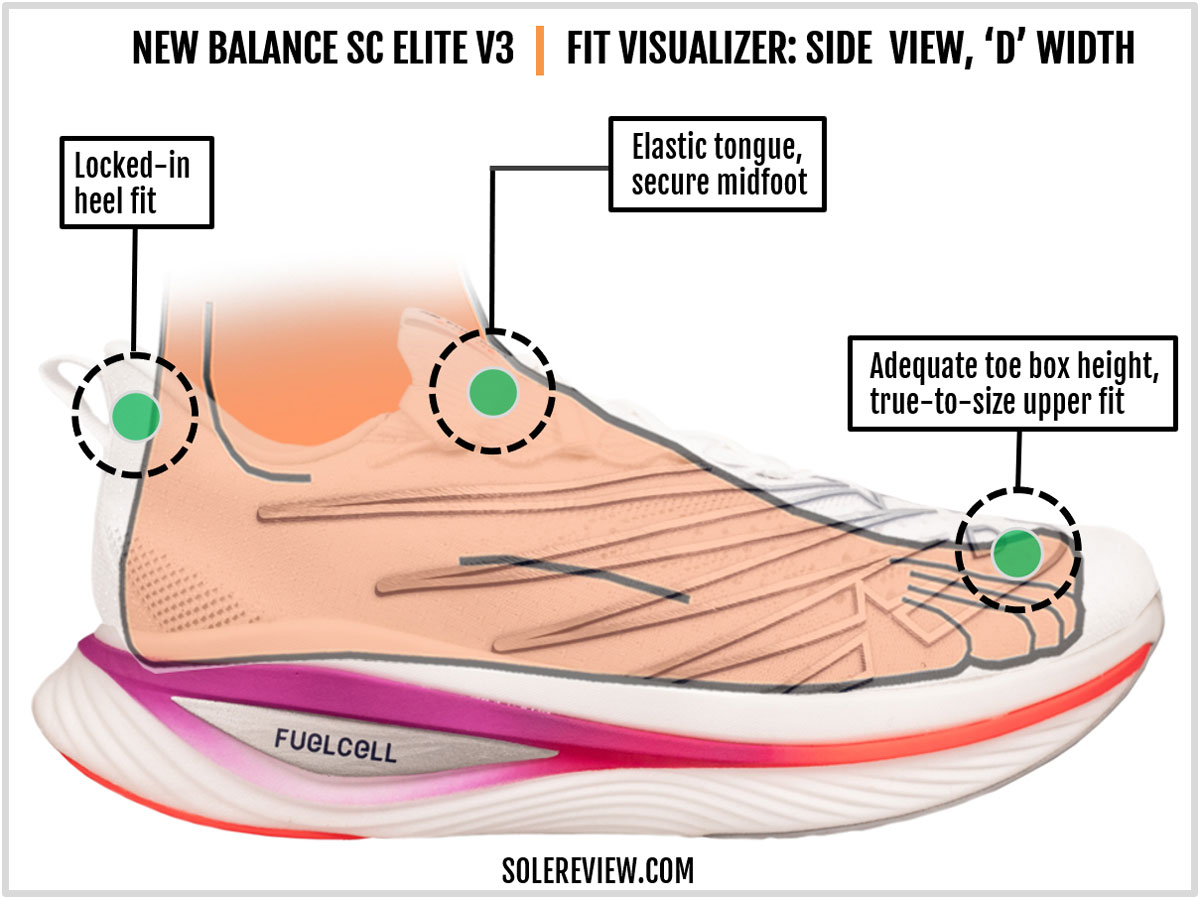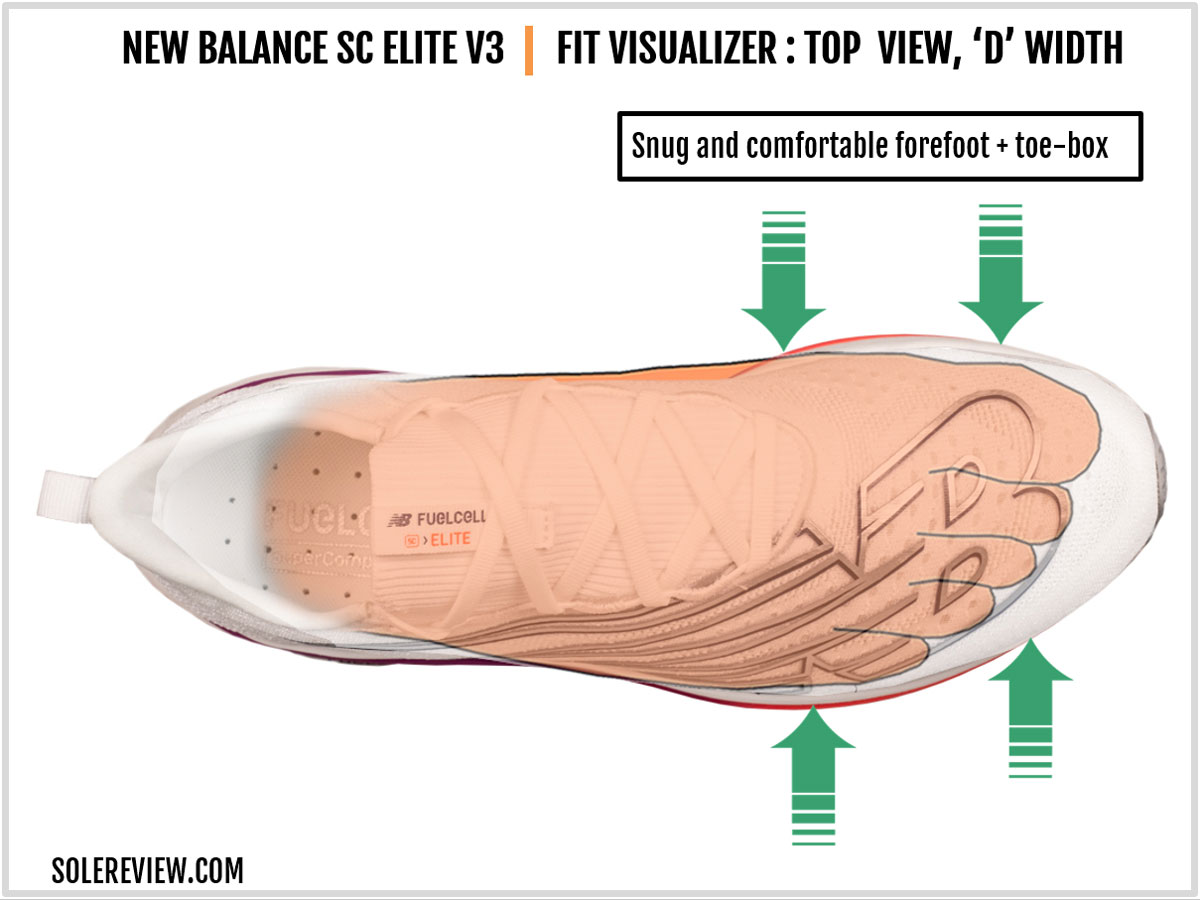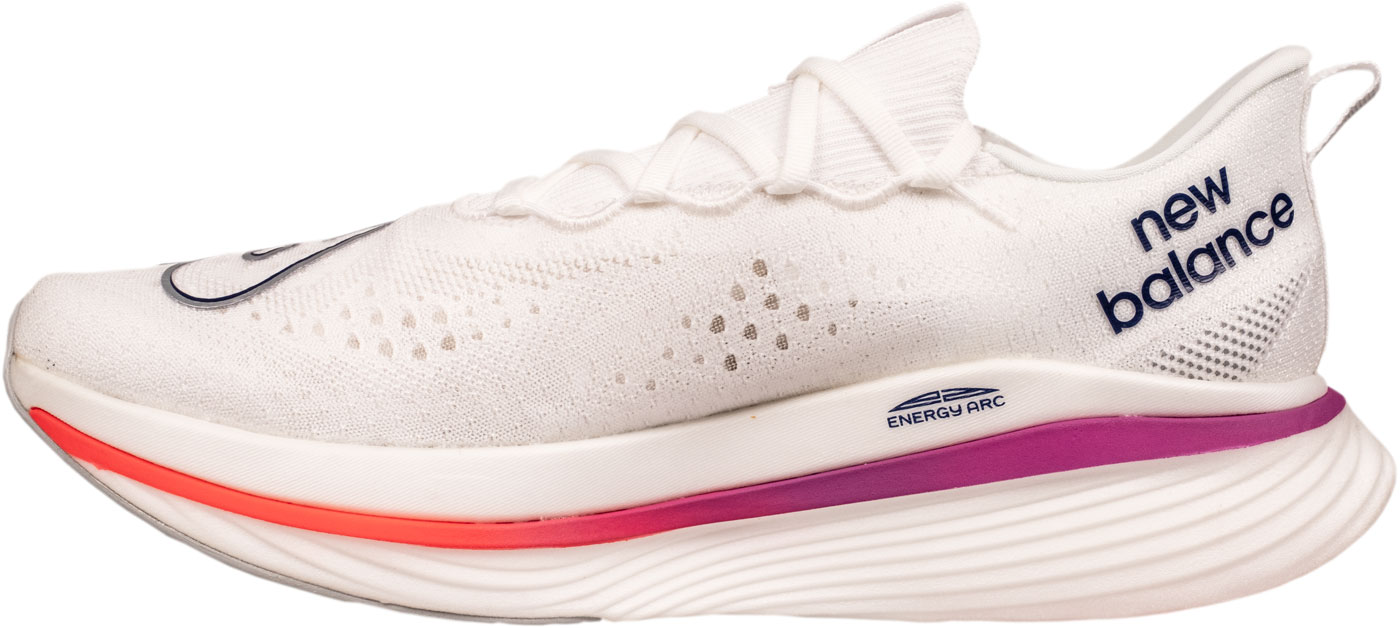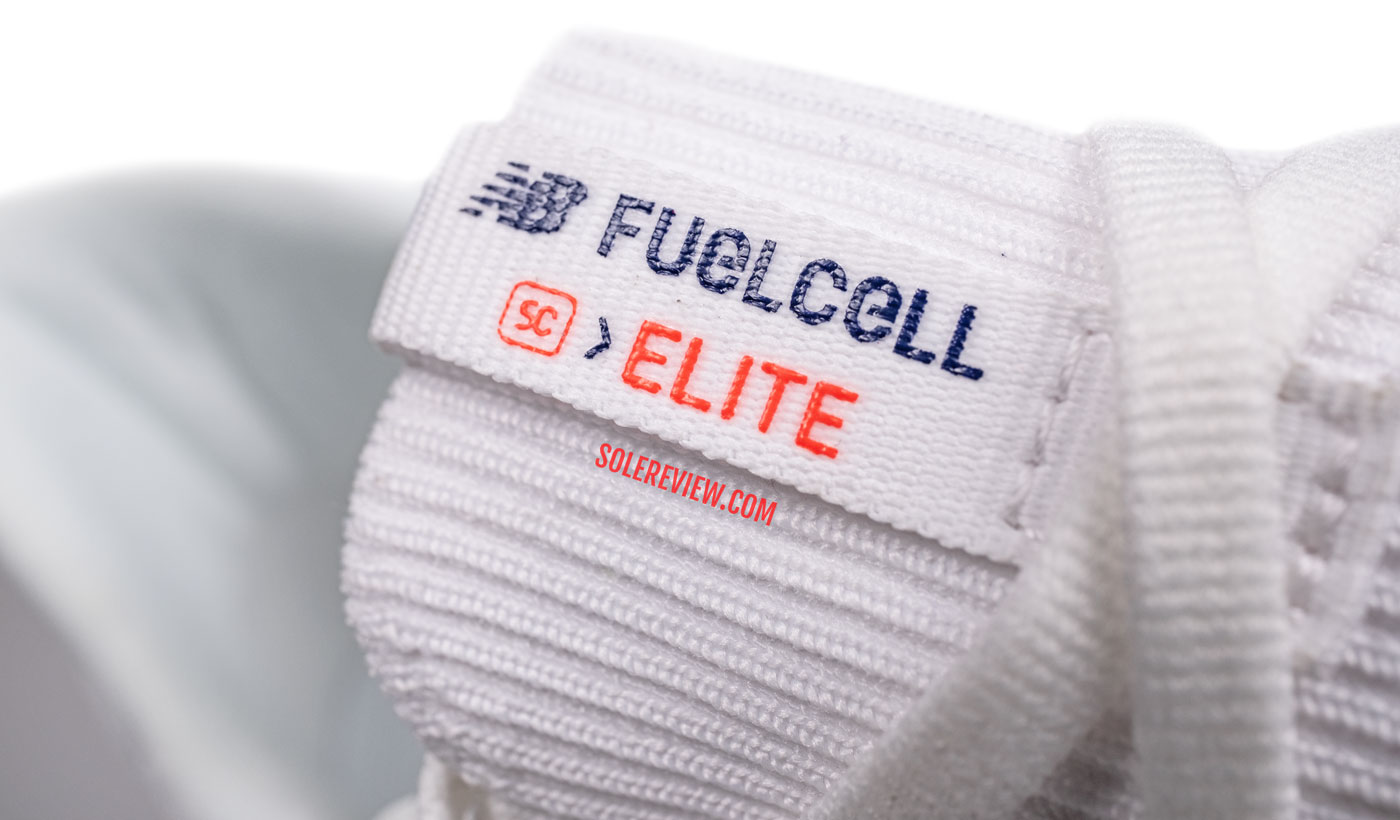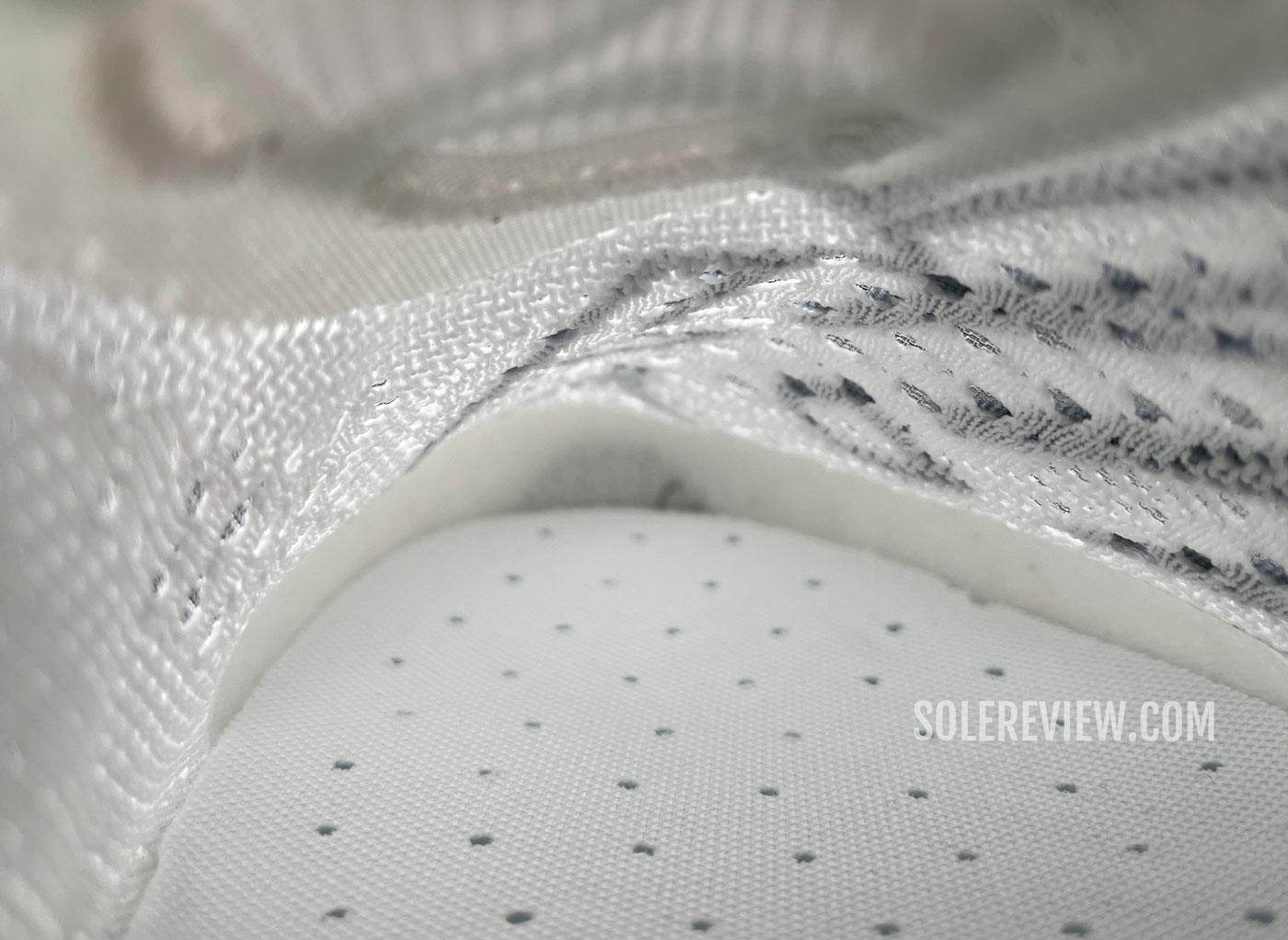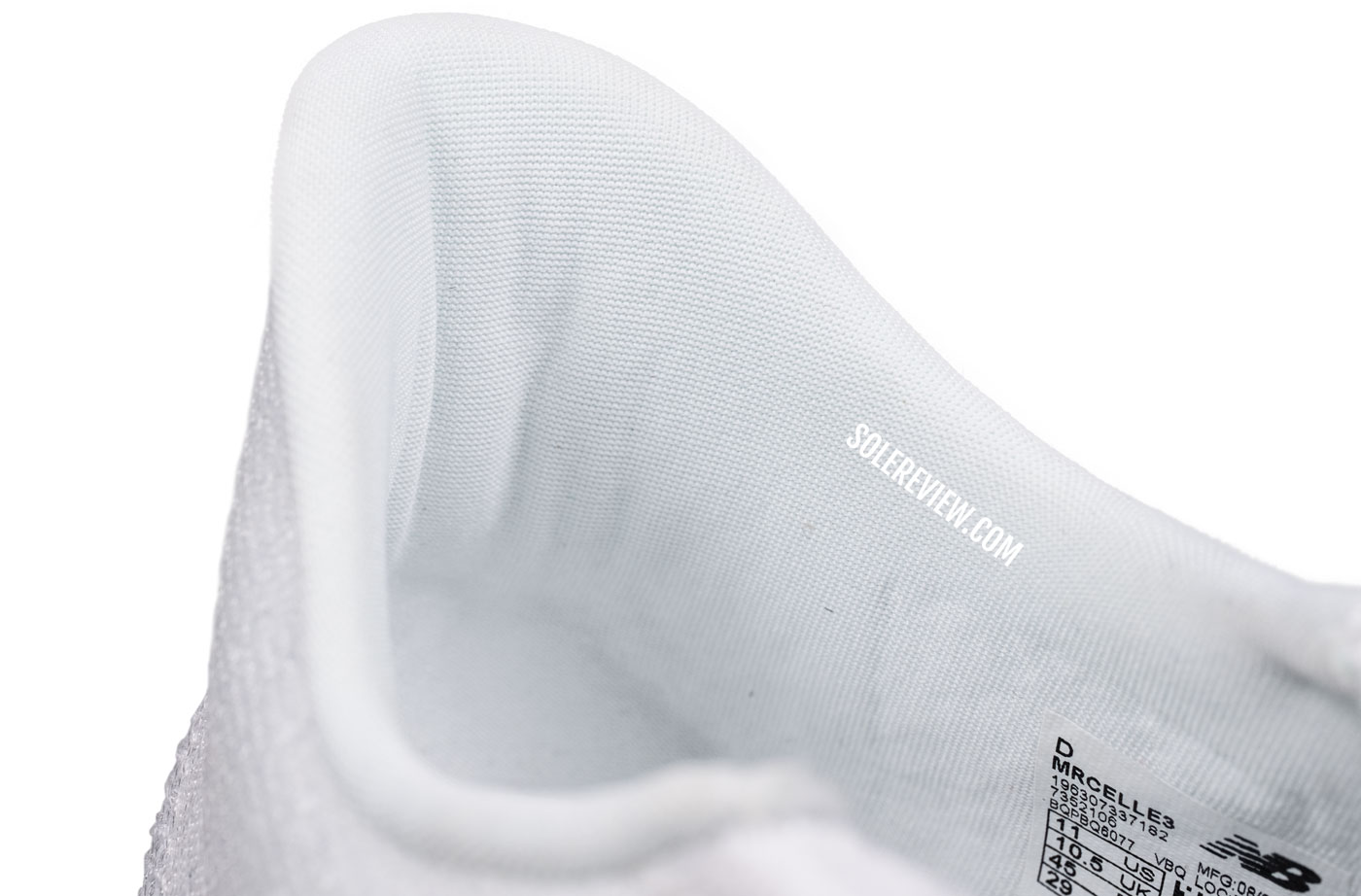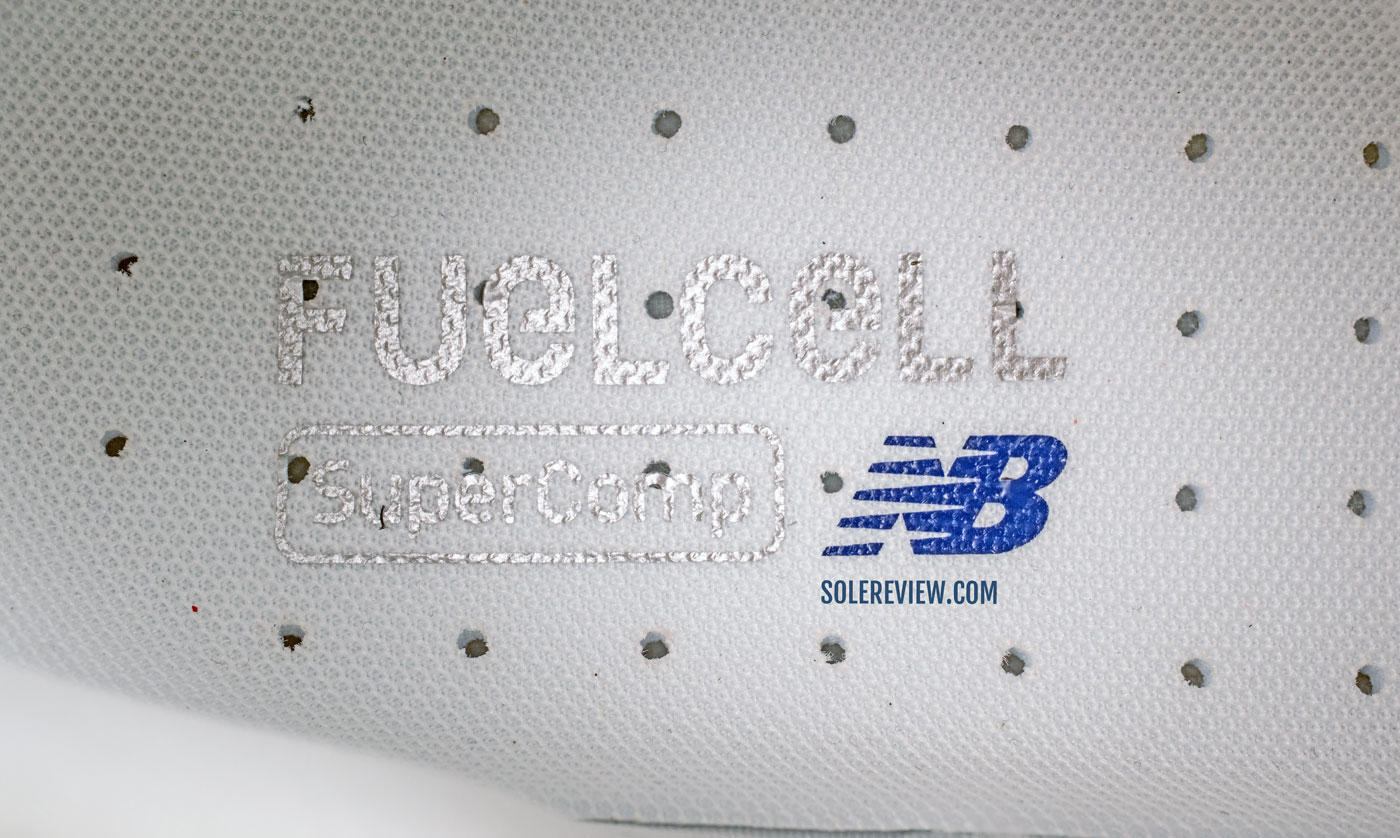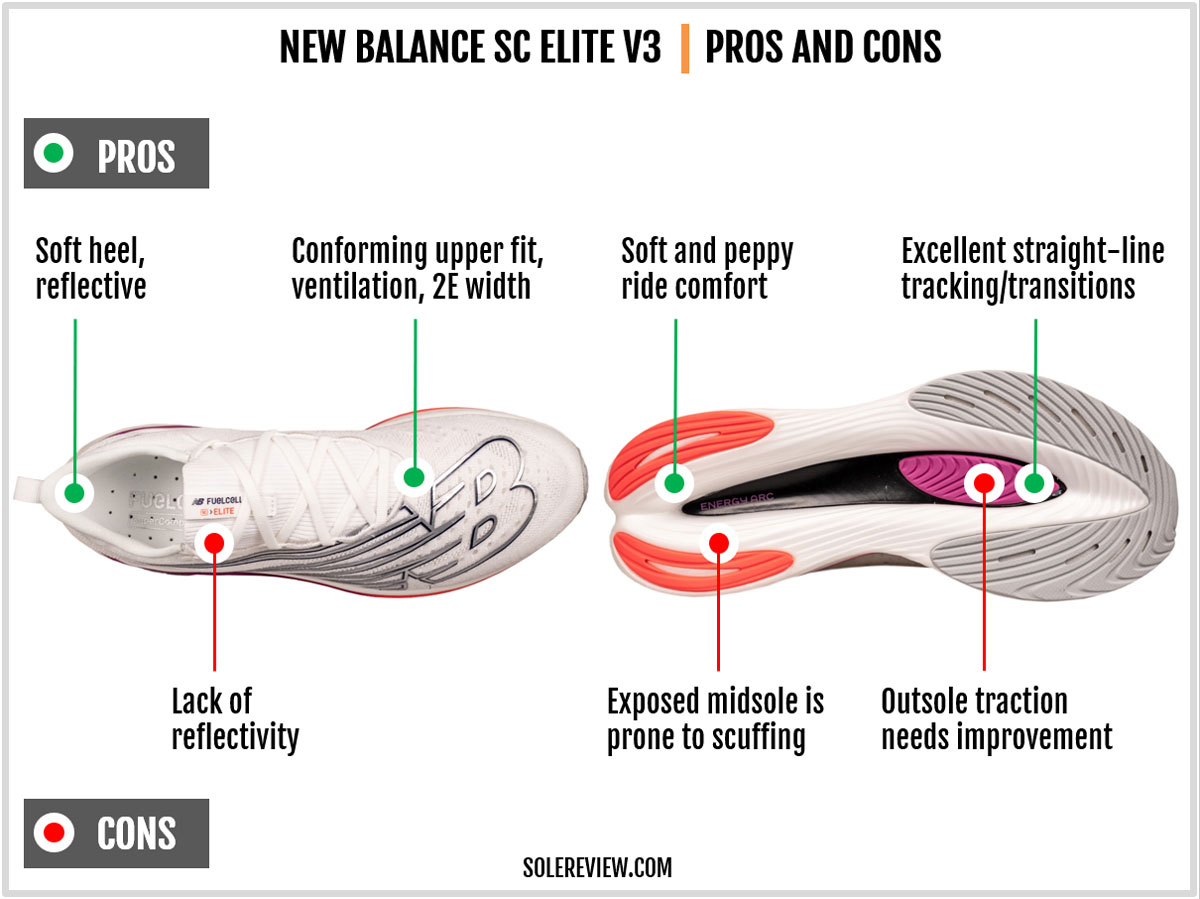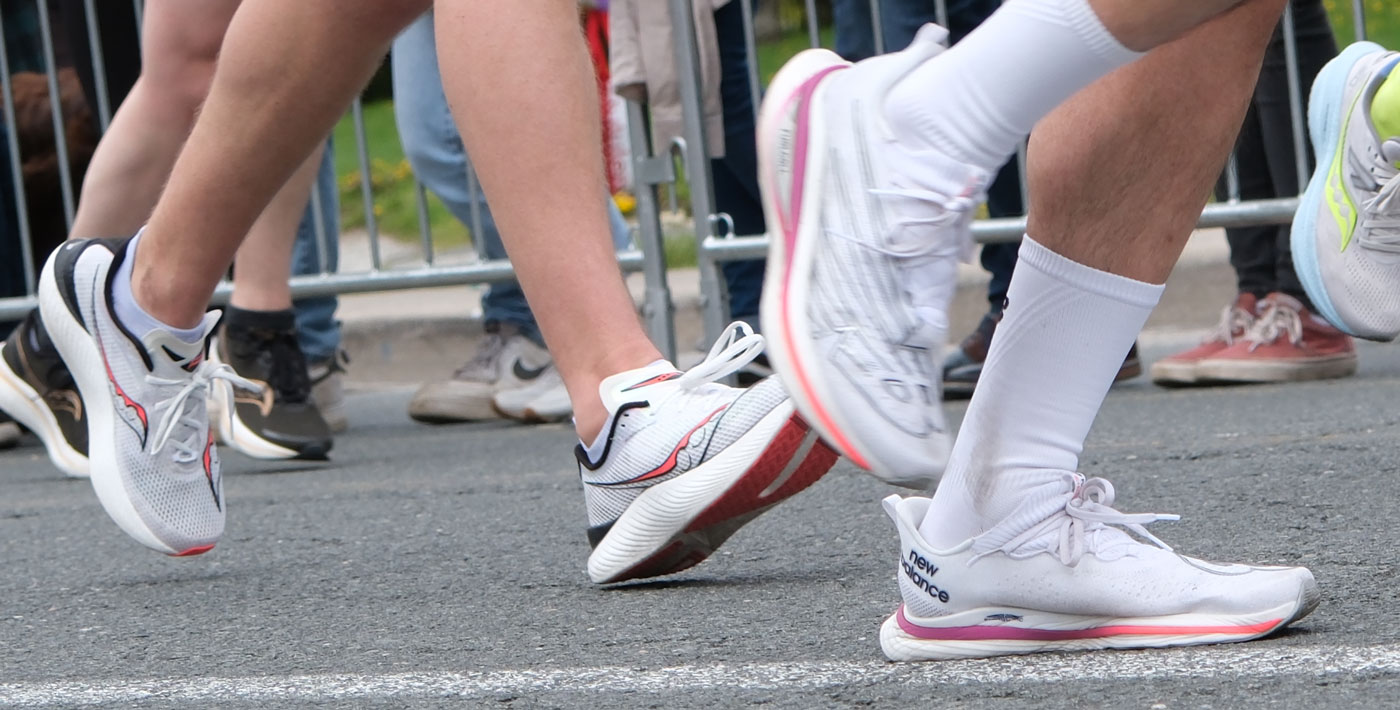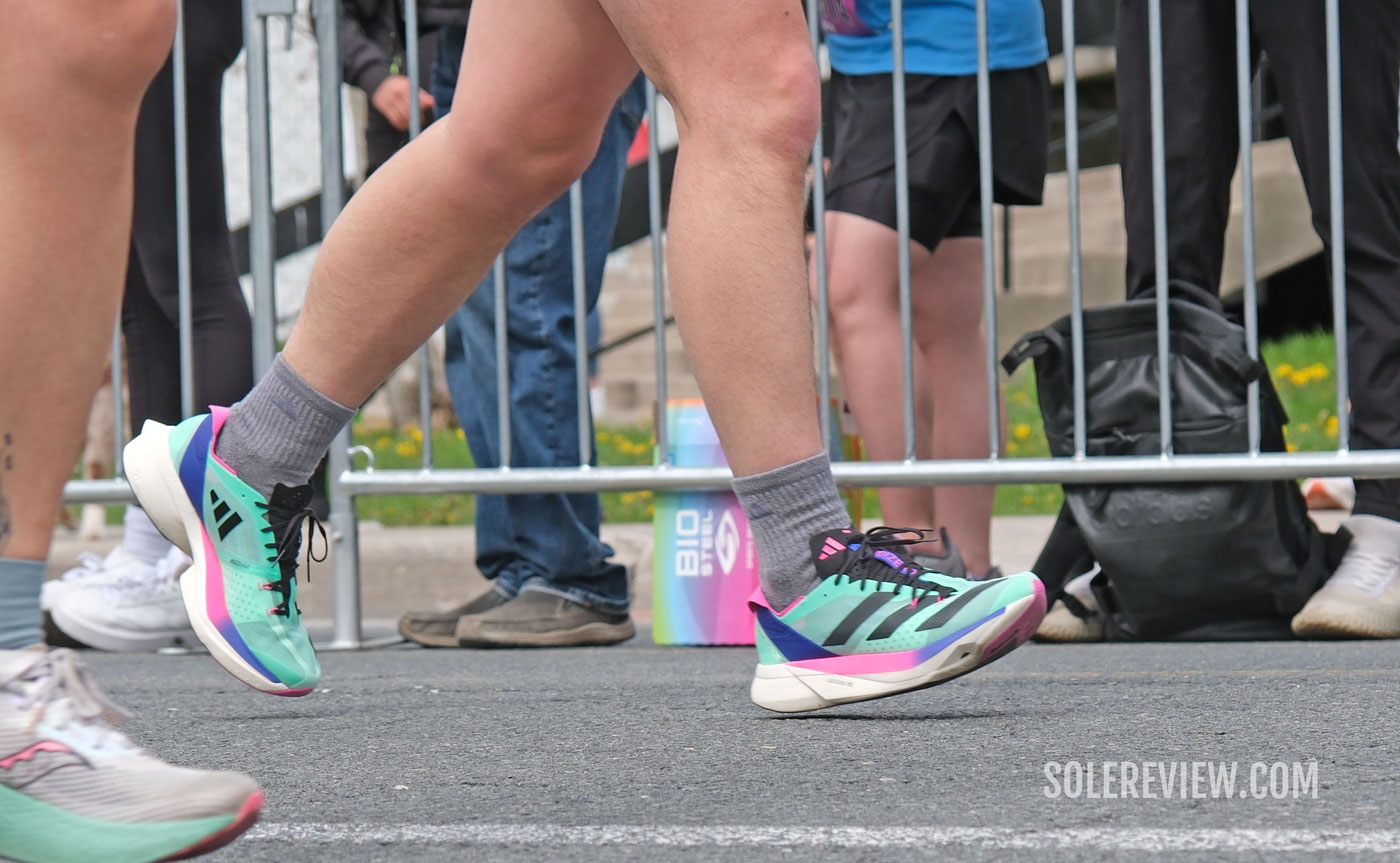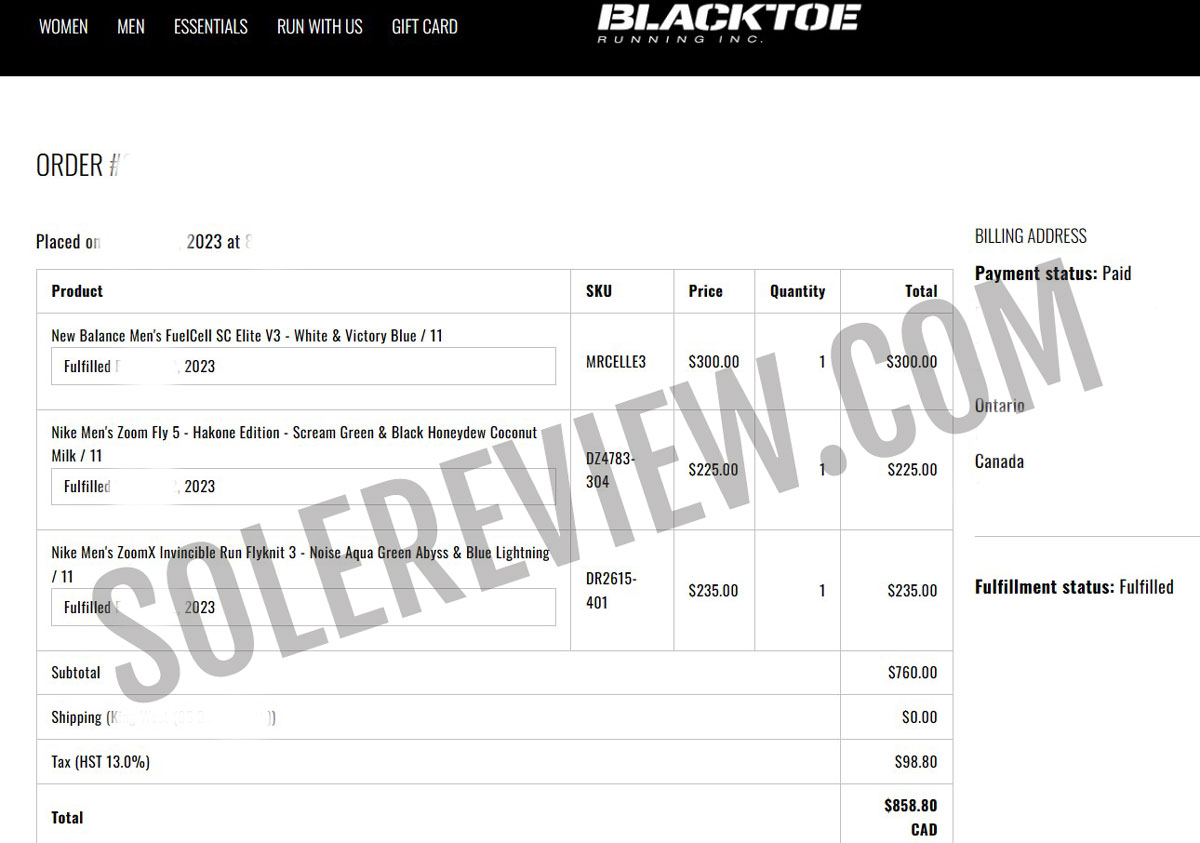
For this review, Solereview paid the full retail price for the New Balance SC Elite V3. The amount is in Canadian Dollars.
In this review:
SUMMARY AND VERDICT
The New Balance SC Elite V3 arrived in early 2023, and it’s been through an interesting journey to get here.
The first in the series – the RC Elite V1 – made its debut in the Wild West of Carbon-plated super shoes. Back then, brands were in a mad rush to get their version of a carbon-plated running shoe to the market.
Some brands like Hoka even didn’t have a super-foam (like PEBAX) to pair the plate with, but went ahead with their EVA foam-based Carbon X anyway. Others, like Saucony, based their shoes on a similar form factor and midsole tech as the Nike Vaporfly.
Four years later, the frenzy has cooled down, and so has the rapid-fire introduction of Carbon-plated racers. Many new releases are now thoughtfully designed, so that’s a sign of maturity in this hyper-competitive segment.
There’s no better example than the SC Elite V3. The evolutionary leap between the RC Elite V2 and SC Elite V3 is huge, so it makes more sense to view the SC Elite V3 as a brand-new shoe rather than an upgraded RC Elite V2.
With its ultra-cushioned and peppy ride, the SC Elite V3 has a similar use case to that of the Saucony Endorphin Pro 3 and Nike Vaporfly 3. It’s an excellent running shoe for marathon training and long-distance races. At the same time, it offers two things that most Carbon-plated super-shoes do not.
The upper fit is often overshadowed by the high-tech midsole design. But when you come across a near-perfect upper fit, it’s only then that you realize what you were missing.
The SC Elite V3’s snug upper fit is easily one of the best of its class; in our detailed upper breakout, we explain why. It’s also the only shoe in this segment to offer an optional ‘wide’ sizing.
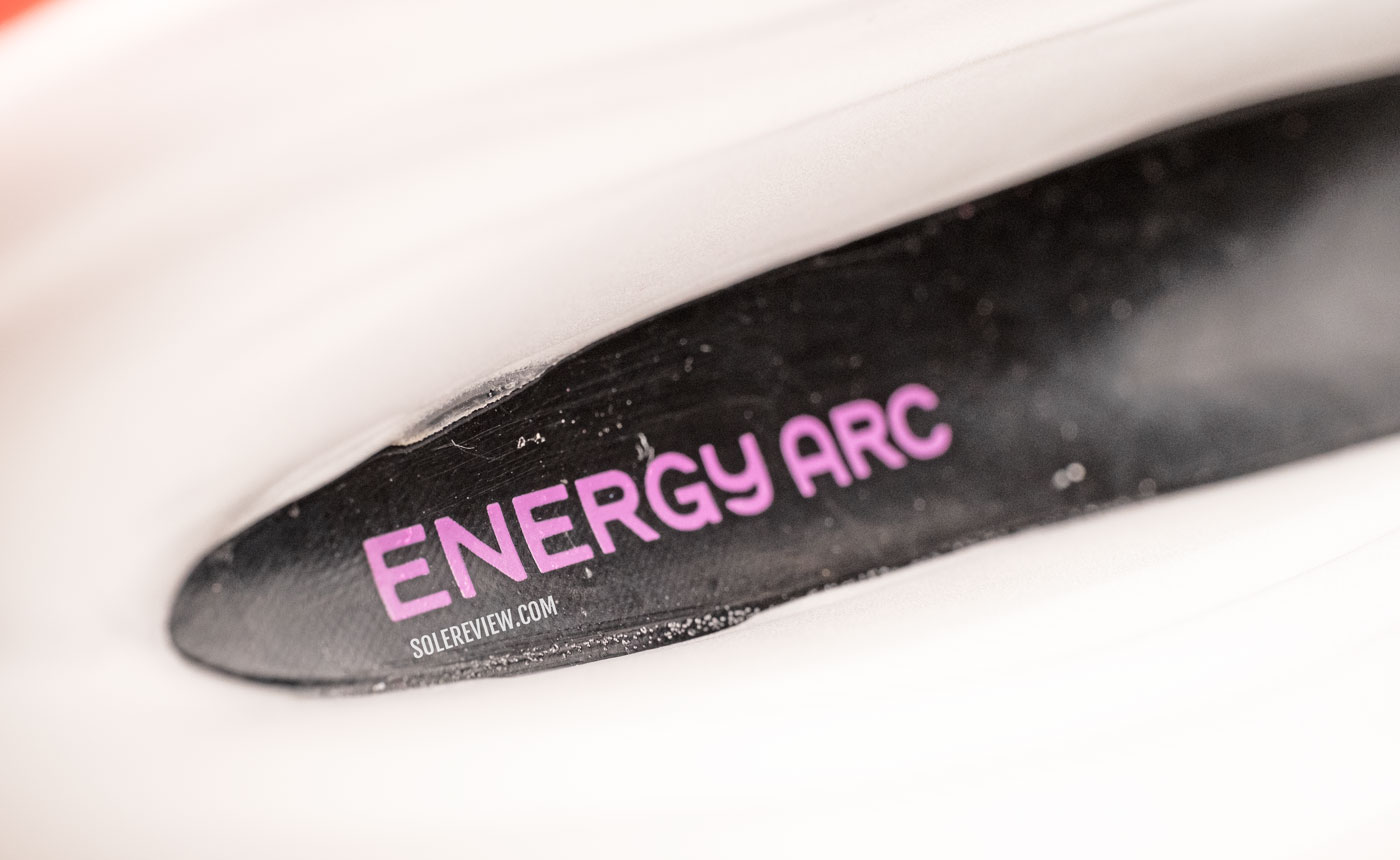
New Balance calls its Carbon fiber plate the ‘Energy Arc’. The plate works together with the wide channel to maintain excellent linear tracking.
The second trait that sets the SC Elite 3 apart from its peers is its exceptional straight-line tracking. For that, we have the outsole design to thank. There’s a deep and wide groove from the heel to the forefoot that exposes the Carbon plate.
This hollow space centers the weight and guides the transitions more efficiently than other plated racers of a comparable softness.
Other than these unique traits, the SC Elite V3 has a similar goal as all super-shoes. It makes long-distance runs less of a chore while allowing for running speeds that personal bests are made of.
From a shoe reviewer’s perspective, the New Balance SC Elite V3 is an excellent buy. While it’s priced the same as the Saucony Endorphin Pro 3 (while undercutting adidas and Nike by $20), this racer’s distinct ride and fit signature will find many takers.
Of all the plated racers we’ve tried (the Vaporfly 3 and Endorphin Elite included), we found the SC Elite V3 to be the most enjoyable.
Based on technical merits alone, the SC might not be truly the best, but it’s the most fun during runs that are 20 kilometers and longer.
THE NEW BALANCE SC ELITE V3 COMPARED WITH THE NEW BALANCE RC ELITE V2
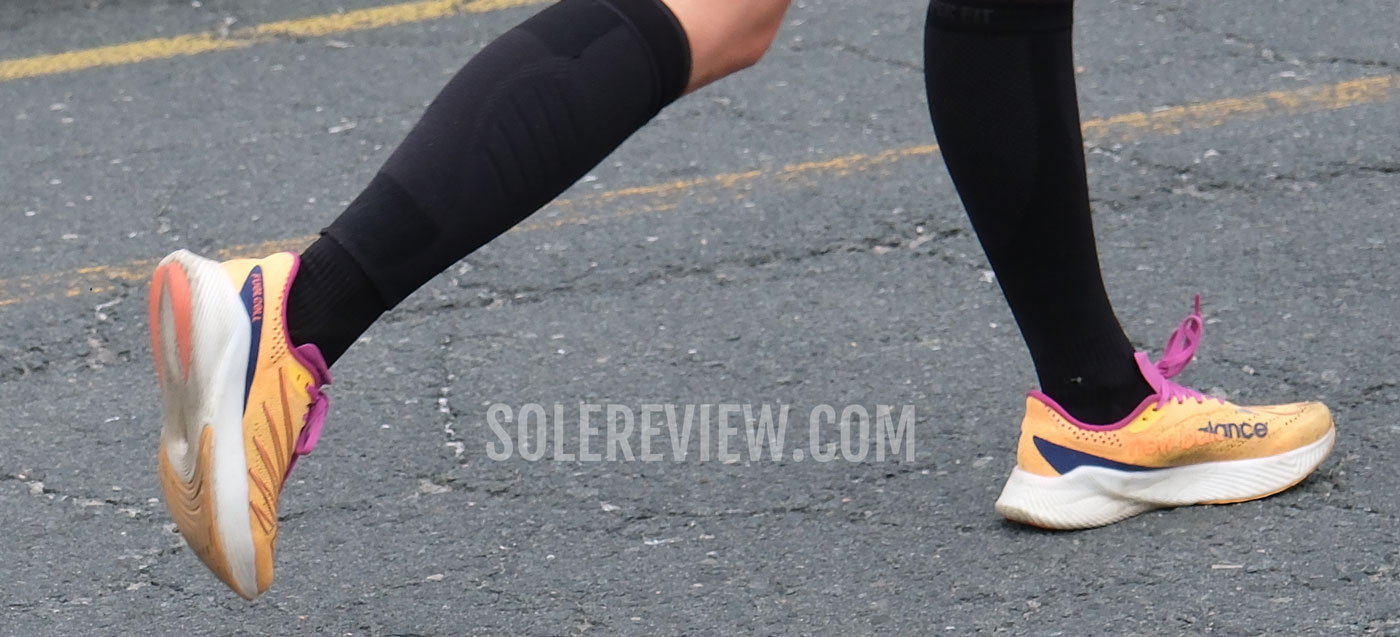
Based on lineage alone, the SC Elite 3 replaces the RC Elite 2. In reality, things are not that simple.
On paper, the SC Elite V3 is an update to the RC Elite V2.
In reality, what’s left of the RC Elite V2 is just a faint outline. The ‘outline’ is the combination of the Fuelcell midsole and Carbon plate. Barring that, everything is brand-new. The old RC Elite V2 as we knew it, no longer exists.
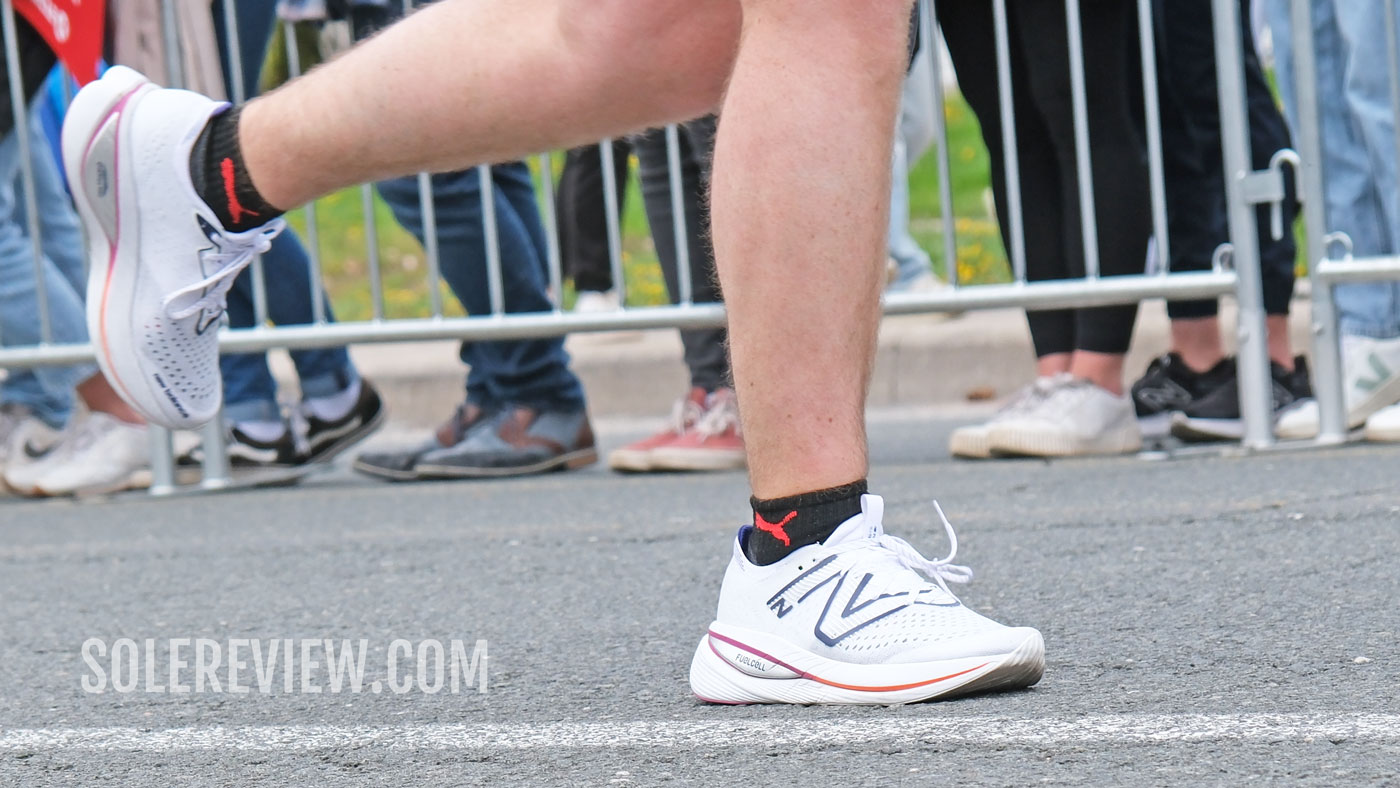
In what’s a reverse design inspiration, the New Balance SC Elite V3’s design is derived from the less expensive Supercomp Trainer.
Here’s another viewpoint that many others will also share: The SC Elite V3 is a higher-tier version of the Supercomp Trainer, but with a lighter Fuelcell foam, lower heel stack, and a race-oriented upper. The SC Elite 3 has more in common with the Supercomp Trainer than it does with the RC Elite 2.
Even the top-level specs suggest a much changed shoe.
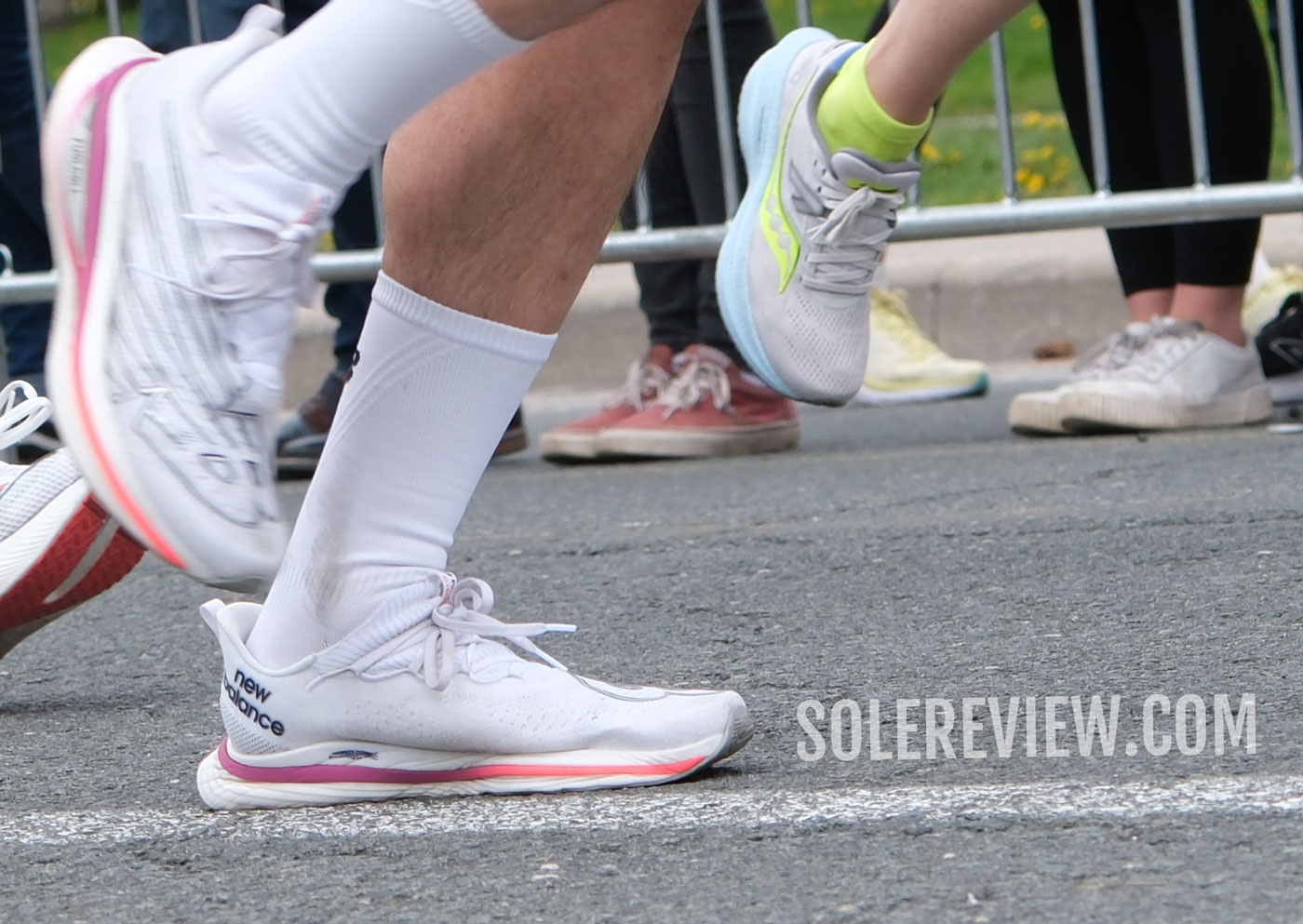
With a new 4 mm heel-to-toe offset, the SC Elite 3’s cushioning is more uniformly distributed throughout the midsole.
The heel-to-toe offset is now lowered to 4 mm, as compared to 8 mm on the RC Elite 2. That’s due to the change in midsole stack heights. The SC Elite V3’s heel maintains a similar thickness (40 mm) as the RC Elite (39 mm), but the forefoot gets taller – increasing from 31 mm to 36 mm.
This update adds more cushioning under the forefoot. There’s a corresponding increase in weight, but it’s too insignificant (up by 12 gm or 0.4 oz per half pair) to make any difference on the road.
Along with the deeper cushioning, the SC offers noticeably superior tracking due to the hollow cavity. The new midsole has a superior quality of transitions, as it keeps the weight centered through the gait cycle. The midsole is now two-part, so the added rigidity from the joint lines manages the foam compression better.
The exposed channel reduces the contact surface of the forefoot outsole, so the SC Elite V3 lacks the bite that makes quick touch-and-go more effective. And if you’re upgrading from the RC Elite V1, you will look back at the grippy DSP outsole with nostalgic fondness.
In practical terms, the SC Elite V3 offers greater stability and ride comfort over the RC Elite V2. The ride also feels more nuanced, whereas the RC Elite V1 and V2 felt like a more cushioned Fuelcell Rebel, but with a plate.
The upper fit isn’t the same either. The SC Elite’s upper sits closer over the foot than the past versions – while the newly-added elastic tongue plays a part, and so does the lacing spread. The only familiar part of the SC’s upper is the printed logo – it’s similar to what the RC Elite had.
THE MIDSOLE DESIGN AND RIDE EXPERIENCE
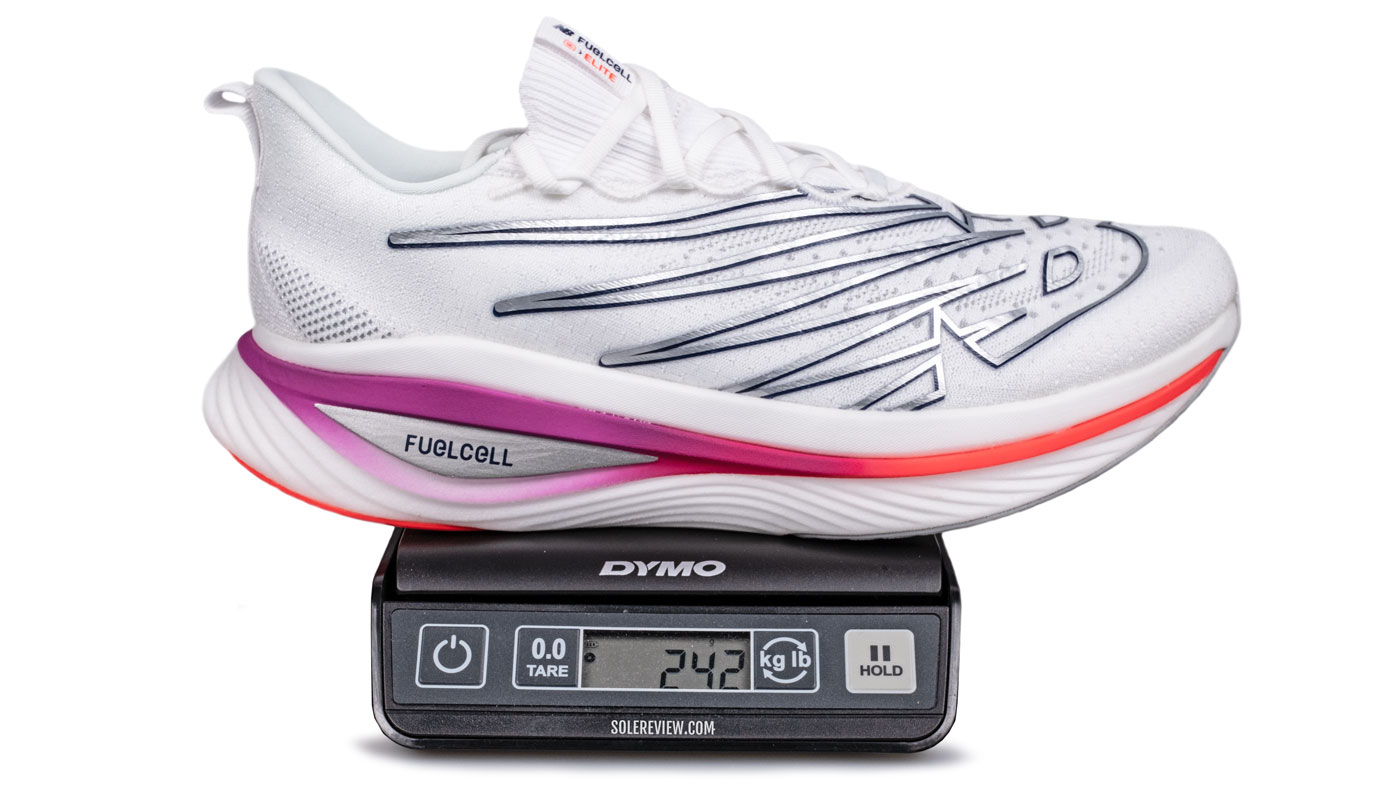
Like most shoes of this class, the lightweight SC Elite 3 disappears over the feet during a race. But there’s more than what meets the eye.
The SC Elite V3 is advertised as a race-day shoe, which it is. The shoe has everything that one expects in a long-distance racer that costs north of $200 – qualities like maximum comfort, disappear-over-the-feet lightness, and a forward-propelling quickness that only a carbon-plated shoe with a rocker midsole can deliver.
Sub 1:30 half marathoners and 3:00 marathoners will find the SC Elite 3 a worthy race-day companion.
But it’s a lot more than just a racing shoe. Its very usable cushioning works for other use cases than just marathons. By that, we refer to the relatively supportive and forgiving nature of the SC Elite.
Though the midsole lacks a particularly wide heel base, the deep hollow channel not only helps center the weight, but also helps the shoe track straight forward. Does anyone remember Asics’s ‘guidance line’? Well, this concept is similar, but cranked up to the max.
Transition grooves aren’t a new concept, and their origin story is fuzzy. They have existed in one form or the other, but New Balance took it to another level with the Supercomp trainer.
The underside of the SC Elite looks virtually indistinguishable from the SC trainer; the depth of the channel follows the curvature of the Carbon plate, with the heel area being the deepest.
As a cushioning material, the Fuelcell foam has a lot to offer. It’s lightweight (the SC Elite is 230 grams/8.1 ounces) and blends soft ride comfort with a lively rebound.
A non-removable insole on top adds some top-layer padding, but its role in the overall cushioning is very limited.
Naturally, not all of the rebound comes from the Fuelcell foam. The Carbon plate is put to work here, as is the case with most racers in this segment. The plate exists to guide the transitions as well as release the spring-like energy stored when initially loaded.
These ingredients mix well together to create a ride quality that not only behaves as a plated racer should, but also has high tolerance to variations in footstrike patterns and running speeds.
On the move, the lightweight SC Elite 3 feels quick yet remarkably comfortable over long-distance runs. The responsive character of the foam-plate blend does its thing, and so does the rocker profile of the midsole.
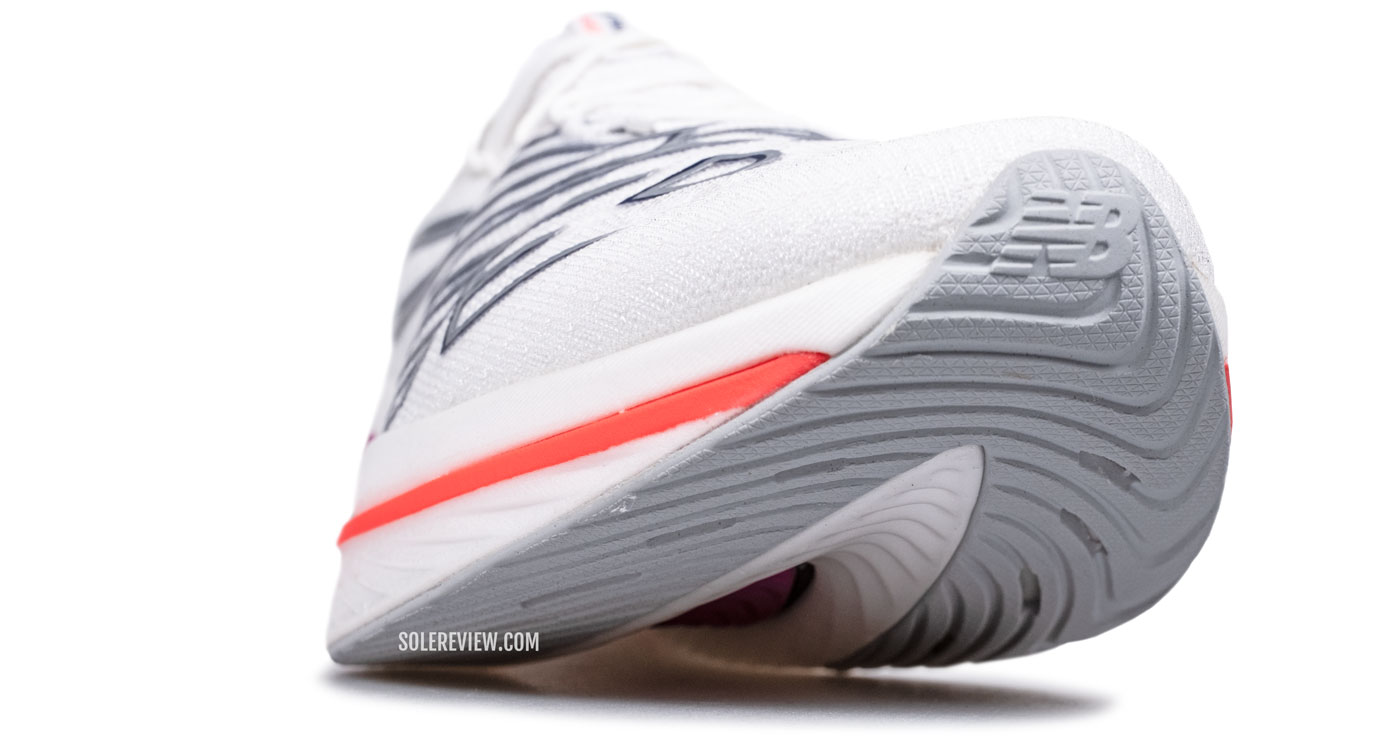
The rocker forefoot ‘tips’ the foot forward for quicker transitions. Also, note that the forefoot outsole piece (in purple) does not make contact with the surface.
The deep transition channel is well integrated with the rocker, so both play very well together. The groove keeps the transitions linear, and rocker helps the foot roll in a forward direction. The outsole lugs are flush with the midsole, so the foam and rubber parts function cohesively.
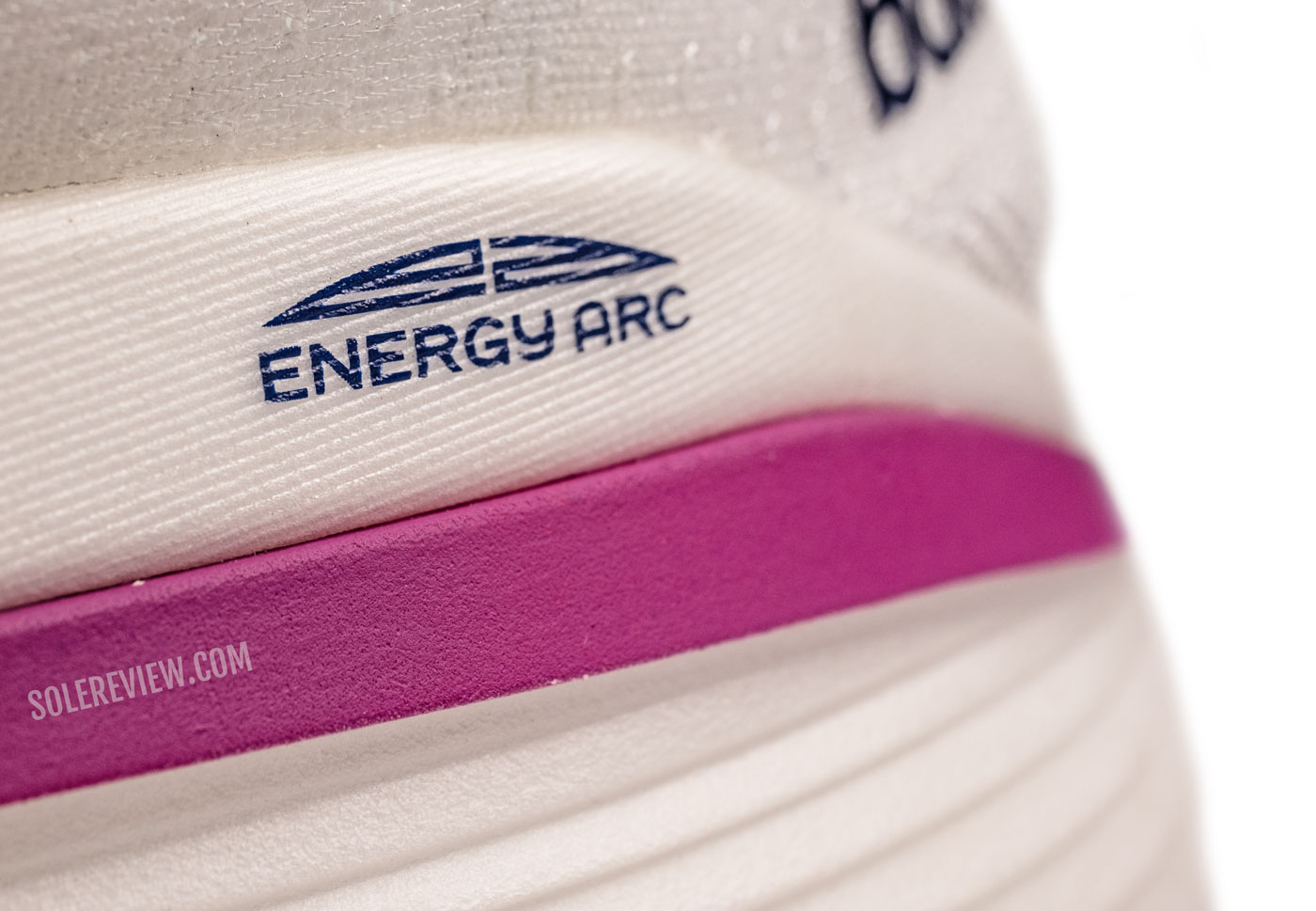
The midsole walls are slightly raised and cups the foot. The midsole above the purple section is a separate piece of Fuelcell foam.
The relatively decent heel stability, high stack height, and heel seating position make the SC Elite V3 friendly towards rearfoot strikers. The performance doesn’t suffer if you decide to take the SC Elite on a long and easy (say, around 9 min/mile) training run either.
Having said that, we don’t recommend using the SC Elite V3 as an everyday trainer. A third of the outsole has exposed Fuelcell foam, so putting everyday miles will be detrimental to the SC Elite’s long-term health.
And that brings us to the strange outsole lug placement under the forefoot. This design is lifted from the Supercomp Trainer, and the lug is just there to look pretty. Even when fully loaded, this purple-colored lug is non-functional, as it barely scrapes the road.
We’re not quite sure why this part of the ‘outsole’ exists. Perhaps the original design intended this to be a functional part. But later during the production process, New Balance may have discovered the limitations of putting the idea into practice.
To be specific, if the lug was thicker and on level with the rest of the outsole, it would have felt lumpy. Why? Unlike the surrounding outsole (in gray) that can ‘telescope’ into the Fuelcell foam when loaded, the purple lug cannot – since it’s mounted on a stiff Carbon plate.
On the other hand, the ‘Energy Arc’ plate has a molded outline built in (for placing the outsole), so leaving the lug out would have looked odd.
As the dead center of the forefoot lacks effective outsole coverage, the traction is a step below the RC Elite V2, and a distant third from the ultra-grippy RC Elite V1.
RECOMMENDED ROTATION
The SC Elite V3, Fuelcell Rebel 3, and 880V13 can make a three-shoe rotation from New Balance work, but there’s a slight hiccup.
Out of the three, the 880 is the only shoe without a Fuelcell midsole, so it feels boring in comparison.
On the other hand, the tempo-friendly and lightweight Rebel V3 isn’t durable enough to be an everyday trainer. The SC Elite doesn’t have a lot of outsole rubber either. The New Balance 1080V12 could stand in for the 880, but we rather wait to see what kind of shoe the 1080 V13 is.
If not confined to a budget, an ideal three-shoe rotation would be – the Asics Superblast for everyday runs (long distance included), the Brooks Hyperion for short races and speed/interval training, and finally the SC Elite for a marathon (or a half.)
IS THE NEW BALANCE SC ELITE V3 DURABLE?
The outsole coverage under the heel isn’t substantial, and there’s a lot of exposed midsole foam. Nonetheless, the rate of wear and tear is fairly controlled.
While midsole foam has mild scuffing, it’s nowhere as flaky as the Vaporfly’s PEBA foam. There’s no visible creasing either. The thin and flexible outsole lugs ‘telescope’ into the soft midsole foam to minimize abrasion.
Here’s a fun observation. The outsole rubber pieces (on the opposite sides) look symmetrical but they are not. Under the heel, the outer lug is wider with a smaller window, as that happens to be a high-wear zone. The same applies to the forefoot; the inner edge takes most of the loading so the rubber piece is wider with fewer slats or windows.
There’s no reinforcement under the single mesh exterior, but we haven’t received adverse feedback. We expect the New Balance SC Elite V3 to last 400 miles under most circumstances.
THE UPPER DESIGN AND FIT
The SC Elite competes against the Saucony’s Endorphin Pro, among several others. The Endorphin has a relatively accommodating toe-box, so the foot feels ‘freer’ inside the upper. The Endorphin Elite has an even wider toe box.
That doesn’t apply to the SC Elite 3. The true-to-size upper has a comparatively pointy toe-box as well as a very snug forefoot and midfoot fit – but in a very productive way.
This is one of those rare fits that leave no gaps between the foot and the upper. This is easier to achieve with a 100% stretch mesh, but the SC Elite 3 is only partially elastic.
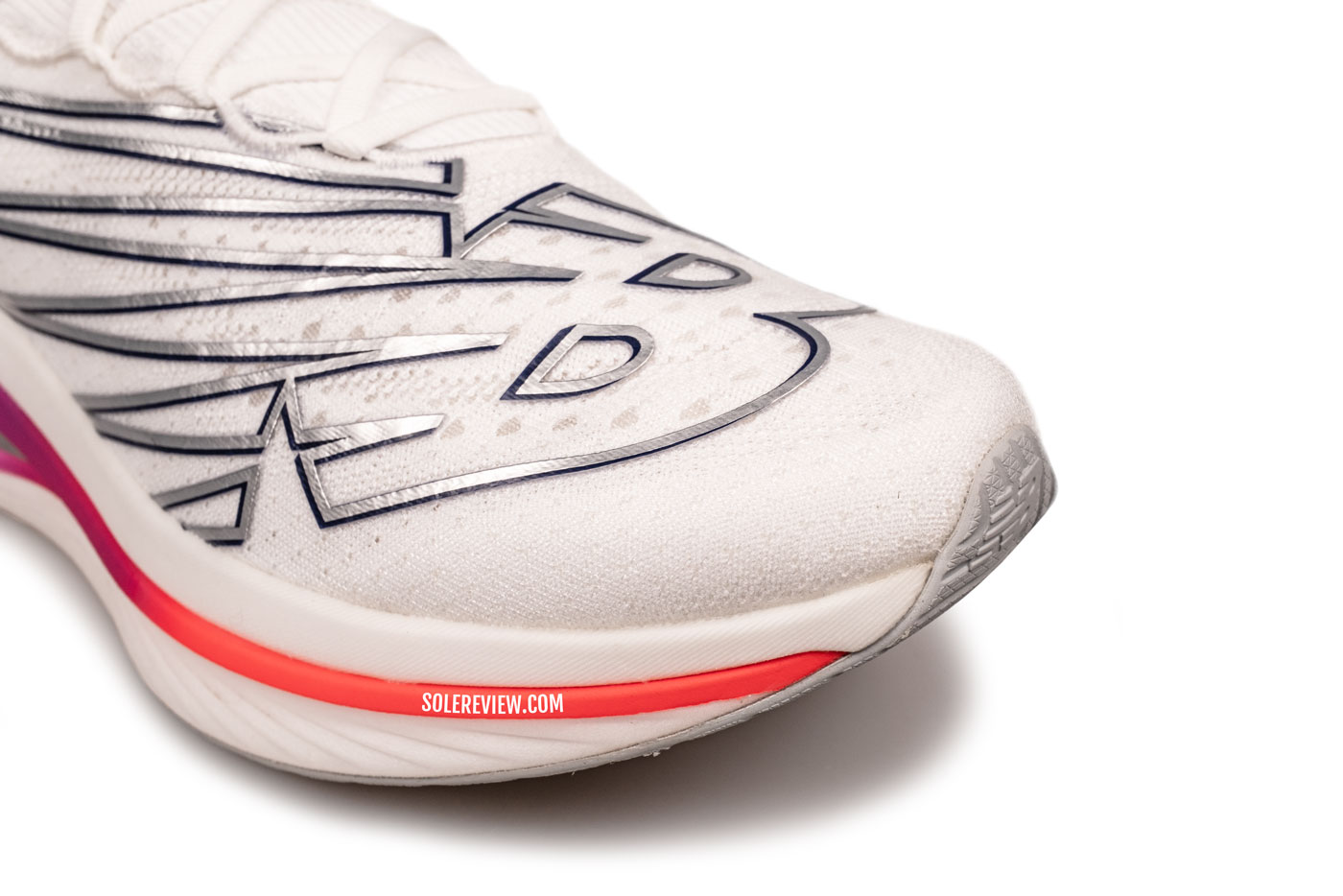
New Balance goes against the prevailing trend, and decides to give the SC Elite 3 a true racer-like upper fit. At the same time, the toe box isn’t shallow.
What’s more, the conforming fit bears down equally on both the large and small toe. This is unlike some shoes (Hoka in particular) that have a snugger inner side (small toe area) with a lower fit pressure over the large toe.
The SC Elite’s upper never squeezes the foot to the point of discomfort – the mesh exterior just does an excellent job of molding itself over the foot. Also, the toe-box height is not shallow.
New Balance took a purist’s approach to the SC Elite’s upper, because this is how traditional racing flats used to fit. At the same time, New Balance also offers an optional 2E width, another rarity in plated super-shoes.
The form-fitting upper is effective at transferring the power from the foot to the midsole, and that’s one of the reasons that makes the New Balance SC Elite 3 so much fun to run in.
The midfoot fit is the best in class. Making that happen is the elastic tongue as well as the lacing design. The large stretch tongue forms a bootie that snaps securely over the foot.
An elastic top panel also makes the (potential) issue of material gathering (or bunching) non-existent. You don’t have to adjust the tongue to get the positioning right; furthermore, the large loop on top makes it easy to pull the tongue over.
On the other hand, the heel loop could be larger – it’s too small, even for the pinky finger.

The lacing spread goes progressively wider from the front to the rear. This makes the cinching more effective.
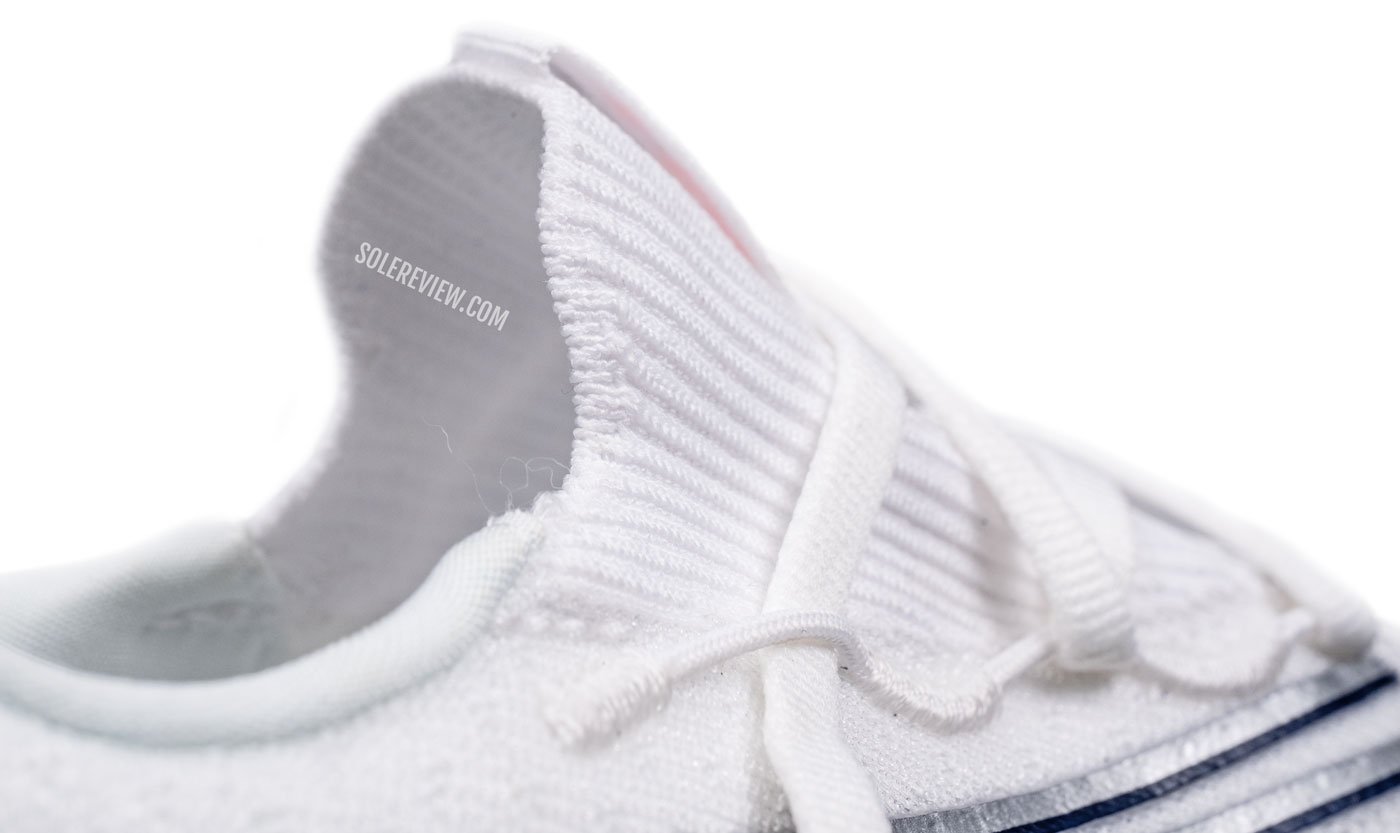
The semi-stretch laces pass through tacked-on loops. The laces bypass the interiors altogether, thus making the insides very smooth.
The lacing spread is clever as well. It starts narrow in the front and progressively widens towards the instep. This makes the lacing more effective, as the widest part of the lacing is squarely on top of the midfoot.
The soft and mildly stretchy laces pass through stitched-over loops, so they don’t pass under the upper. This construction keeps the insides very smooth and irritation-free.
The ventilation is sufficient for what the occasion demands. The upper isn’t a sieve like the Vaporfly 3 and Endorphin Pro, but the vents let the air circulate without obstruction.
There aren’t any reflective details on the upper. There’s a distinctive New Balance logo located in a prominent position (called a ‘TV logo’ in the industry), but it’s non-reflective. However, the print details aren’t merely cosmetic, as it helps the upper retain its shape by adding structure.
Despite the low levels of heel padding, there’s no slippage at all.
The heel fit is every bit as good as the rest of the upper. Here, the heel depth and the molded stiffener locks the heel in place. There’s a stiff counter inside, so the heel is not foldable.
ORTHOTIC COMPATIBILITY
The SC Elite V3’s insole is pasted to the midsole lasting, so the upper has a low compatibility with an orthotic.
Adding another layer of foam is going to make the fit tighter as well as dilute the lively nature of the Fuelcell midsole.
In this case, it’s a better idea to find a marathon racer with a removable footbed. The Saucony Endorphin Speed 3 has a standard replaceable sockliner, and the Endorphin Pro 3 has a thinner but removable insole.
PROS AND CONS
We don’t know of any other shoe in this class that offers an optional ‘wide’ fit, so that’s a brownie point right there. While the snug fit of the regular width is excellent for security and power transfer, it’s reassuring to know that a wide version is available on demand.
If you’re one of those runners who find the standard fit perfect, you’re in for a treat. The upper is soft, breathable, and structured (or elastic) where it needs to be. The lack of reflectivity makes the SC Elite 3 a poor choice for dawn or dusk runs, and that’s the only shortcoming on the upper worth noting.
The secure upper is effective at directing the power to the midsole – which happens to be one of the best things about the SC Elite 3.
The dual-layer Fuelcell midsole is comfortable as it is lightweight and quick. The Carbon plate and deep transition groove help the shoe track forward while adding the signature pop of Carbon-plated racers.
SHOES COMPARABLE TO THE NEW BALANCE SUPERCOMP ELITE V3
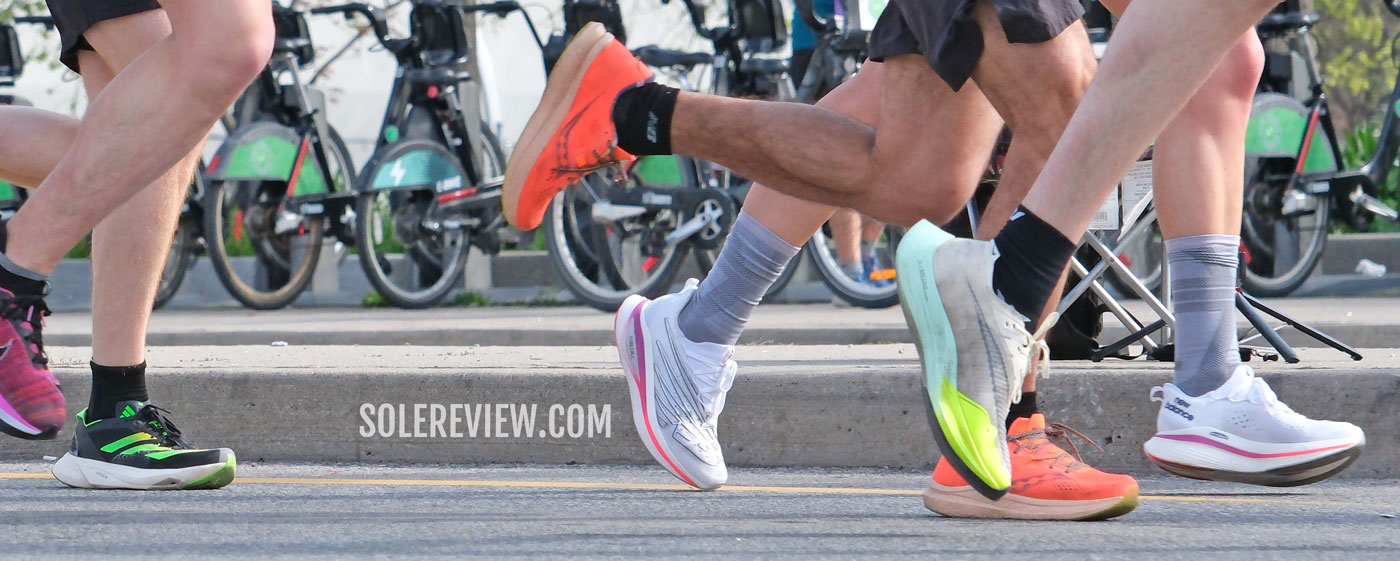
There are signs of maturity in the super shoe segment; most of the popular models have their shtick locked in.
The max-cushioned racers in the $200+ super-shoe segment are in the early stages of maturity. Or perhaps not – the upcoming $500 adidas Adios Pro Evo 1 makes $250 price tags look poverty-class. Maybe this is the dreaded hyperinflation that central bankers often talk about.
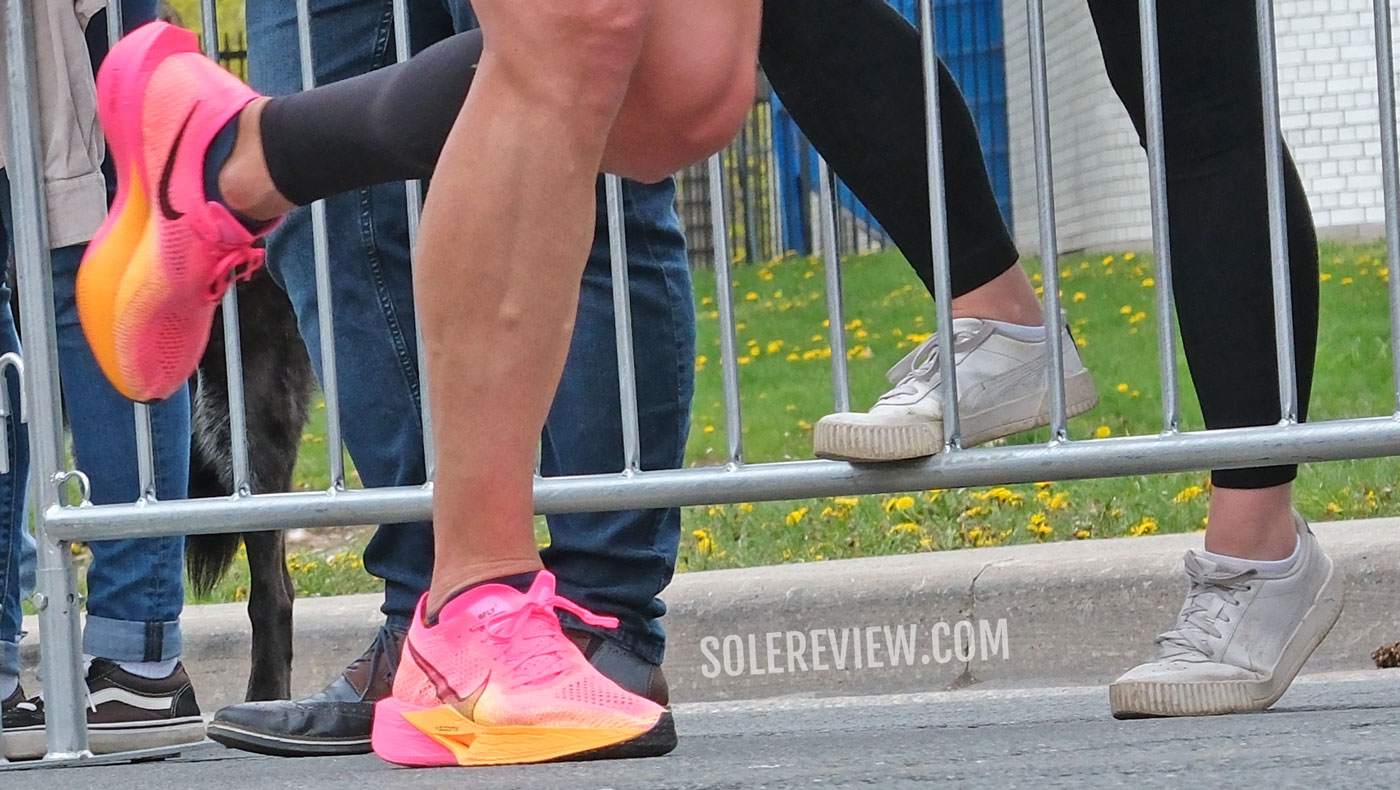
On the Nike Vaporfly 3, speed marries ride comfort – thanks to the PEBA foam midsole and its Carbon plate.
Our point being – most shoes in this segment have carved out their niches with familiar quirks and idiosyncrasies. Despite its redesigned ZoomX midsole and Carbon plate, the Nike Vaporfly 3’s ride signature is similar to the VF 1 and V2, and so are its known failings. In plain words, you should know what you’re buying.
Saucony’s Endorphin Pro 3 is priced the same as the SC Elite V3, and it’s closely matched in many performance areas.
The Pwrrun PB (PEBA foam) cushioning marries marathon-worthy comfort with speed-enabling manners – thanks to the Carbon plate and rocker midsole. While the upper doesn’t have the conforming fit of the SC Elite, it makes up with its extremely well-ventilated upper.
Runners who seek a firmer ride will find that in the adidas Adios Pro 3 or the Brooks Hyperion Elite 4. That’s because these racers combine a plate with a non-PEBA foam midsole, rather than relying on softer cushioning materials. Brooks uses a nitrogen-infused foam (DNA Flash) that also features on the Hyperion and Hyperion Max.
Hoka sells a few shoes with plates in them, but the absence of a super-foam translates into a non-comparable ride experience. Plated shoes from Hoka are great for shorter runs though.
The Asics Metaspeed Sky (and Edge) also compete in this space, but they’re closer to the New Balance RC Elite V2 rather than the SC Elite.
Do you own this shoe? Improve this review by sharing your insights.

